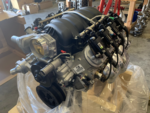- Welcome to the Ford Mustang forum built for owners of the Mustang GT350, BOSS 302, GT500, and all other S550, S197, SN95, Fox Body and older Mustangs set up for open track days, road racing, and/or autocross. Join our forum, interact with others, share your build, and help us strengthen this community!
You are using an out of date browser. It may not display this or other websites correctly.
You should upgrade or use an alternative browser.
You should upgrade or use an alternative browser.
Vorshlag Build Thread - 67 Mustang Pro Touring/Track Car Build Thread
- Thread starterFair
- Start date
This site may earn a commission from merchant affiliate links, including eBay, Amazon, and others.
More options
Who Replied?Flyboygsxr
ADAM
My 1967 mustang track car. I decided to do an LS swap and picked up this crate LS7 from GM performance. 7 liters of dry sump goodness. 500whp in a 2600lb car should be funYep.
What is she going in??
Flyboygsxr
ADAM
$10.5k, brand new from GM performance. Same engine as the 2015 Z28s and C7 Z06s. With a set of headers I think we should be just over 500hp at the tire. The previous engine was an iron block 302 that made about 300hp.Whats the Bad News?? What did she cost ya??
JDee
Ancient Racer
$10.5k, brand new from GM performance. Same engine as the 2015 Z28s and C7 Z06s. With a set of headers I think we should be just over 500hp at the tire. The previous engine was an iron block 302 that made about 300hp.
Can't blame ya man.
I keep thinking about those pictures from Vorshlag showing the Coyote and LS side by side in a pair of S550s. Envious about how much of that weight is being carried lower and more centered and you have to believe it would make a big difference in the handling of the car. Heresy, I know, but sometimes you just have to see the sense of different approaches to a problem.
I love the sophistication and modern design of the 'yote, but the better weight placement in an equal power package is very very appealing.
If I ever lunch the Coyote it's going to be a tough decision.......
Flyboygsxr
ADAM
The packaging and weight were a big part of the decision making to go with the LS7. To fit the coyote would have meant a lot of fabrication and removal of the shock towers, etc. The LS7 is lighter and pushed further back so the engine is almost completely behind the front axles. We found a set of off the shelf headers that fit too so it just made more sense. Also the LS7 with headers makes more power and torque than even the voodoo 5.2L. The old of adage about displacement, 427c.i. makes 500hp effortless. The older I get the more I become just a car guy, whatever works best, not brand loyal as long as it’s AmericanCan't blame ya man.
I keep thinking about those pictures from Vorshlag showing the Coyote and LS side by side in a pair of S550s. Envious about how much of that weight is being carried lower and more centered and you have to believe it would make a big difference in the handling of the car. Heresy, I know, but sometimes you just have to see the sense of different approaches to a problem.
I love the sophistication and modern design of the 'yote, but the better weight placement in an equal power package is very very appealing.
If I ever lunch the Coyote it's going to be a tough decision.......
Hard to argue the convenience, even though it feels so wrong! It’s too bad that Ford Performance hasn’t packaged a Windsor based 408 or 427 with the modern fuel injection and ignition - it would easily accomplish the same goals and would keep it in the family. Hard to justify financially I’m sure when the pushrod technology has been obsolete in their OE lineup for 20+ years.
Flyboygsxr
ADAM
Maybe if I put a ford sticker on the intake manifold no one will know? LolHard to argue the convenience, even though it feels so wrong! It’s too bad that Ford Performance hasn’t packaged a Windsor based 408 or 427 with the modern fuel injection and ignition - it would easily accomplish the same goals and would keep it in the family. Hard to justify financially I’m sure when the pushrod technology has been obsolete in their OE lineup for 20+ years.
I think I got lucky with the timing of the LS7 purchase as they normally sell for $14-15k ish.
We also just ordered a fuel cell and a set of MCS double adjustable coil overs for the front suspension. We are running S197 front hubs and 14” brembos. That along with 315 width tires on a light car should equal lots of smiles.
Flyboygsxr
ADAM
Fuel cell, engine and trans are installed. Waiting on the MCS coilovers, ford racing hubs and 14" brembos, and the Holley Terminator engine management system with the Holley digital dash. Everything has been ordered, the Covid has slowed everything down.
There are three tire selections I'm looking at. Since we started the build the idea has been to use the BFG Rival S 1.5's in 315/30R18 on all four corners. I've been doing some research and the Advan A052 seems to be a better tire in the 200TW category. My gut is telling me to go with the PS4S 285/35/R18 because I want a tire that I can track wet or dry. I know I can run two different sets of wheels for the wet and dry as a compromise. Driving a car around with 315's on the street when it only weighs 2600lbs doesn't seem like a great combination. The tram lining will likely be atrocious on the street. Thoughts?
I'm excited to get this thing done. Initially the idea was to run it at LS Fest at NCM in September if it's not cancelled.
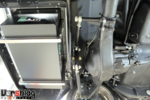
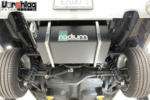
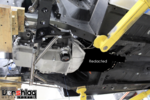
There are three tire selections I'm looking at. Since we started the build the idea has been to use the BFG Rival S 1.5's in 315/30R18 on all four corners. I've been doing some research and the Advan A052 seems to be a better tire in the 200TW category. My gut is telling me to go with the PS4S 285/35/R18 because I want a tire that I can track wet or dry. I know I can run two different sets of wheels for the wet and dry as a compromise. Driving a car around with 315's on the street when it only weighs 2600lbs doesn't seem like a great combination. The tram lining will likely be atrocious on the street. Thoughts?
I'm excited to get this thing done. Initially the idea was to run it at LS Fest at NCM in September if it's not cancelled.



- Thread starter
- #31
Project Update for May 28th, 2020: A lot has happened with this project since we began work last November. We have the AJE tubular front crossmember installed, 18x11" wheels are on hand that fit under the stock bodywork, a 427" LS7 dry sump crate engine has been installed with a manual transmission, the Radium Engineering fuel cell is installed, and we have started work on the roll cage.
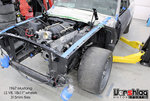
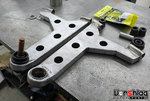
We have also removed the old front suspension & brakes and sold it, removed the old 302/T5 drivetrain and sold it, installed composite doors, fixed the floors, designed and built new front suspension, and installed modern Brembo brakes / hubs / spindles from an S197 Mustang.
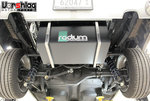
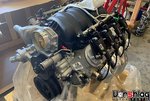
We did much of this work this Spring while we were semi-shut down, with our crew working about half their hours to create a bit of social distancing, and already spread pretty thin on a number of ongoing projects. But we have great progress, and you can see that in the update below.
PICK FRONT CROSSMEMBER + SUSPENSION DESIGN
I talked about front suspension options last time, after we looked at a lot of "modern" replacement front crossmembers / suspensions / brakes, and felt that for this build we needed something... a little different. While it would have been fun to spend $20-30K on some of the really fancy Corvette based front "suspension in a box" kits, they just didn't fit this car's budget or needs. This is to be a track car, not a show car. There are no "Design and Engineering" judges to impress - just looking for lower lap times, more reliability, and and superior driveability.
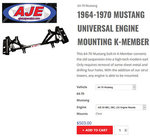
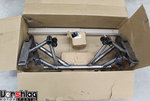
Our engineering group here at Vorshlag looked at all of the options and we picked the AJE tubular front crossmember made for the 1st gen Mustang. We talked to the folks at AJE and they agreed to send us one of this units but not powder coated, in case we need to move suspension pickup points and/or weld something onto their fabricated piece here. It arrived in a few weeks and the construction and welds looked great.

This is normally paired with their SN95 Mustang spindles, their control arms, some drag type struts and top mounts, and SN95 Mustang brakes. Of course we aren't building a drag car here, and had another spindle in mind to use with a modified strut design - the 2005-14 Mustang S197 spindle. This offers more modern brake options, better hubs, and more advanced geometry.
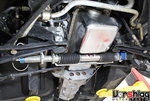
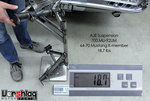
This tubular design seems a bit lightweight compared to the OEM crossmembers we have worked with in the past on S197 and S550 Mustangs. We might add a little more steel to this AJE assembly, as we plan to put lateral grip from 315mm tires through this thing. But remember - the '67 came in here with NO lower crossmember up front, so this is already much stronger than what it had. Time to get this installed.
WAIT... FRONT STRUTS?
Yes, we are converting this car to have a modern version of a McPherson Strut front suspension. This will replace a front suspension system designed in the early 1960s that packages very poorly and has pretty poor geometry. I am sure some of you are rolling your eyes, but remember - strut cars don't necessarily suck. We have sold thousands of high end strut and shock setups for a variety of cars that have won thousands upon thousands of races.
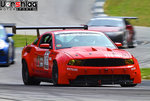
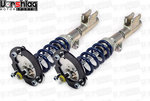
If you think we are going to make this car somehow slower with this "lowly strut suspension", you haven't been paying attention to race results. This '67 will will have the same struts / brakes / ABS / spindles as our 2011 GT above, which did pretty well in NASA, Optima, and other competition arenas - along with hundreds of other track focused S197s we have built or supplied. The '67 will also have 315mm tires, but be one thousand pounds lighter than our 2011 GT, and it will have more power.
REMOVE EXISTING DRIVETRAIN
This work started November 14th, 2019. The car "drove" into the shop with a running, carbed "late model" 5.0L HO engine from a 1985-93 Mustang. It had a T5 Z-spec 5 speed behind it with a hydraulic master/TOB conversion driving the Ford 9" built by Currie. The exhaust was off when it got here, however, and it was having some tuning issues, so I didn't get to drive before we tore it down - but the owner had done a number of track events with this built engine and T5 trans before.
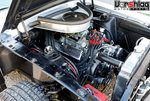
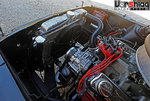
The brake balance was so poor on track (made up of all Wilwood bits) that it turn the tires into "squares" every time he tried to use the brakes hard on track (he tracked a late model GT350 before this car). Ideally I would have liked to have driven the car beforehand, maybe put in some baseline laps at MSR or put it on a chassis dyno for a baseline power number. After building / owning / tuning / driving a number of engines and cars from the Fox Mustang era, and looking at the parts list, I suspect it made around 275-325 whp. That range seems low by today's standards, but that's a somewhat lofty number for a '85-93 5.0L with a cam and heads. A T5 won't live long with much more than that, as many people know, so the upper 325 whp number is probably opimistic.
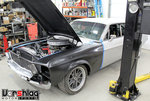
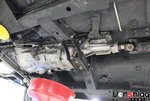
Brad and Evan removed everything ahead of the rear axle in the drivetrain. Fluids were drained, we scarified a chicken to the Ford Gods, and began the "travesty" of yet another LS swap. Driveshaft out, then it was time to dig into the MSD, distributor, and all of the rest that would never go back into this car.
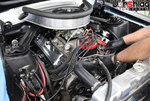
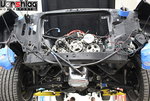
Care was taken to not damage any paint, existing chassis wiring, or any of the parts we were removing. Our customer is not on the Book of Face so we were taking pictures of the drivetrain to help him sell it - to help fund the work here.
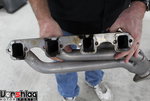
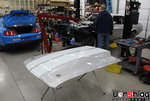
The owner was chasing some exhaust leak issues, but Brad found the leak, at the header. The composite cowl hood was removed before we began and will not be going back onto this car, as the extra height is not needed with an LS engine. A flat composite hood will do just fine.
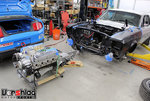
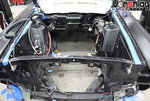
After a little work we had the drivetrain out and intact, ready to live life in another Ford car some day. Engine bay looked pretty cleared out at this point, but we needed to keep going.
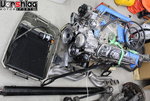
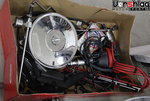
One of the more industrious Mustang parts hustlers in Texas - who had bought a nasty Fox Mustang chassis from me before - came and got all of this drivetrain as well as all of the suspension / brake / bodywork shown below.
REMOVE SUSPENSION, PREP FOR STRUT CONVERSION
During the same week as the drivetrain work above happened the aftermarket front suspension and brake parts came off this car for the last time.
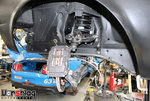
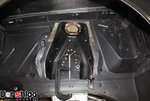
The "double A-arm" front suspension in the 1st gen Mustangs has an unusual layout. First, the spring sits ABOVE the upper control arm, which gobbles up a LOT of inboard wheel room up front. Then there are the two lower control arms, which includes the "Tension Control" rod. It really is a hot mess, but hey, it was designed almost 60 years ago. All of that came off, including the "spring pocket" above the control arm. We aren't going back with anything like this.
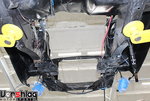
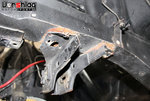
The main lateral control arm's lower mount is a wrap-around structure that forms the inner shock towers as well as the lower structure, shown above right. These were original welded bits held in place with dozens of tack welds. Ford didn't really do corrosion protection all that well back in the 1960s, but this car spent most of its life in Texas so the raw metal underneath was mostly just dusted with surface rust.
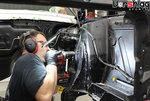
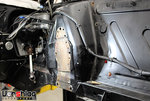
Evan fought this battle for a couple of days: finding and marking spot welds, center punching them, then drilling them out. The spot weld cutter gave way to a unibit for most of this work. The inner shock tower structure that tack welds on was removed but the "strut tower" structure was left in place. If we needed the room for the LS swap we could take out some of this to make room (we didn't need to).
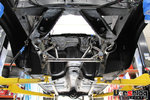
At this point we mocked up the AJE crossmember with some clamps. There was some fore-aft adjustment we could use on the crossmember if we needed to alter the engine placement or control arm pickup points. But those front "TC" rod mounts had to go next.
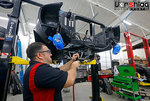
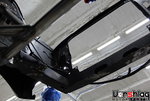
Even used more spot weld drilling and a little prybar work to get those brackets out of the way. The lower radiator support was still in good shape, too.
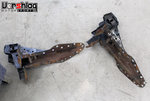
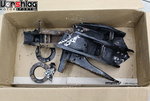
There was some inner shock tower "rings" that were removed (on box above right) but I missed that step. We had more work planned for the strut towers later. The welded structures were all kept to show the customer, then made their way to the scrap metal bin.
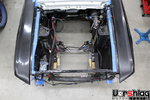
Jason, Myles and I looked at the placement of the crossmember and figured the LS engine would "tell us" if we needed to move this forward, to clear oil pans or alter the control arm placement. For now we left it where AJE intended.
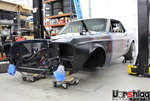
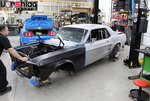
Since the old front suspension was now "gone for good" our crew made some "skates" that bolted to the front frame rails. These help us roll the car around the shop between stations and tasks. We do not have an unlimited number of work bays so we juggle cars around between fab areas, 2 and 4 post lifts, and "storage" areas.
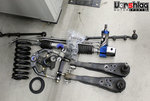

To help expedite the sale of the old suspension (and to make room in our shop) I posted the control arms, steering rack, spindles, brakes, engine and trans in January of 2020.
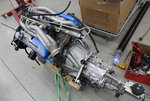
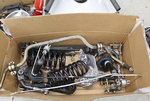
The same guy bought all of it plus the steel front fenders and the cowl hood, which was a nice haul of parts for him. I wasn't a huge fan of the cowl hood and the owner agreed - we will stick with a simple OEM style hood (but likely composite). The sale of all of these parts funded the build for several months, too.
ROLL CAGE, GUTTED INTERIOR, & COMPOSITE DOORS
This '67 came into our shop with a 4-point roll bar welded in place, but built around the stock interior. We were looking at possibly just repairing some of the design aspects that we felt were incorrect or less safe than they could be.
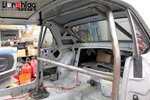
For a dual purpose street/track car, a properly designed 4-point roll bar (or "half cage") is a great alternative for track use. It gives you some rollover protection plus a solid place to to hang shoulder harnesses from, all without putting steel tubes next to your head, arms and legs - which can do more damage than good when street driving without a helmet / 6-point harness. But this one had some issues...
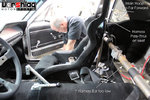
The main hoop was too far forward, pushing into the seats. The horizontal harness bar was mounted too low, which is pretty obvious when you saw the seats / harnesses it came in with. This can lead to a compressed spine when the shoulder belts are pulled tight in a forward crash. The rear "downbars" are also more of a drag race style that land way back in the trunk, near the rear bumper.
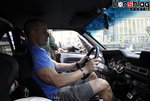
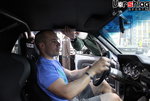
The owner of this Mustang (Adam) came by in late November for a seat "fitting", and we talked about modifying his 4-point roll bar to make it safer. We looked at his existing Corbeau seats (above left) which were sitting WAY too high. Then mock up a lower mounted seat using a Sparco (above right), which gained him a lot of headroom. We also showed him where an upper door bar tube would run if we built a cage ahead of the 4-point.
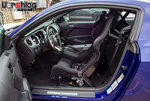
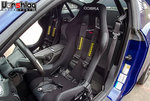
I was more than OK letting this car leave here with the 4-point, if we cut out out, relocated the main hoop, raised the harness bar, added a diagonal in the main hoop, and made changes to the rear down tubes. We have done a LOT of these in dual purpose street/track cars, and I stand behind those setups as the better compromise for a car that is street driven. But in the month since we started the build on this '67, Adam got the bug to go further with the safety upgrades, and the scope creep began...
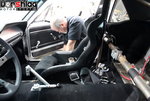
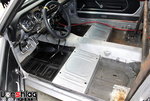
We saved him a chunk of money by not going with an expensive "front clip in a box" that he felt it could be better spent on more serious safety upgrades. Full fire system, full cage, gutted doors (that then morphed into composite doors), and a stripped interior. This was all Adam, but since he waited quite a long time to get his car in here, it was hard to say "No" to more safety.
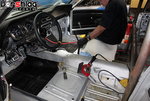
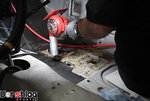
Brad removed the seats, headliner and carpets - the flammable bits that make a street car more livable but a race car more dangerous. This car had some work done previously and the front "tar paper" insulating materials seemed new. The rears were not. Brad used heat and gentle scraping to remove the tar paper, which is no longer needed when you have the carpets removed. Read more about removing this vile stuff here.
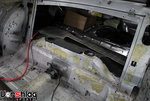
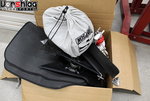
Brad removed the same stuff from the trunk and back seat areas along with the floor mats, visors, some speakers and some other bits.
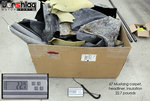
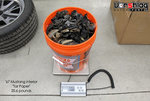
All told we removed 43.3 pounds of carpet and insulation, not counting the seats (which would go back in - or something similar to these). That might offset a chunk of the weight we will add by changing from the 4-point bar to a full 6-point roll cage.
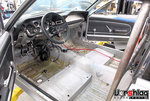
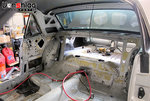
At this point the interior was stripped, and we had cut out the 4-point roll bar. I will show more of the cage construction in a future post. Before that work began, we had to deal with the floors.
continued below


We have also removed the old front suspension & brakes and sold it, removed the old 302/T5 drivetrain and sold it, installed composite doors, fixed the floors, designed and built new front suspension, and installed modern Brembo brakes / hubs / spindles from an S197 Mustang.


We did much of this work this Spring while we were semi-shut down, with our crew working about half their hours to create a bit of social distancing, and already spread pretty thin on a number of ongoing projects. But we have great progress, and you can see that in the update below.
PICK FRONT CROSSMEMBER + SUSPENSION DESIGN
I talked about front suspension options last time, after we looked at a lot of "modern" replacement front crossmembers / suspensions / brakes, and felt that for this build we needed something... a little different. While it would have been fun to spend $20-30K on some of the really fancy Corvette based front "suspension in a box" kits, they just didn't fit this car's budget or needs. This is to be a track car, not a show car. There are no "Design and Engineering" judges to impress - just looking for lower lap times, more reliability, and and superior driveability.


Our engineering group here at Vorshlag looked at all of the options and we picked the AJE tubular front crossmember made for the 1st gen Mustang. We talked to the folks at AJE and they agreed to send us one of this units but not powder coated, in case we need to move suspension pickup points and/or weld something onto their fabricated piece here. It arrived in a few weeks and the construction and welds looked great.

This is normally paired with their SN95 Mustang spindles, their control arms, some drag type struts and top mounts, and SN95 Mustang brakes. Of course we aren't building a drag car here, and had another spindle in mind to use with a modified strut design - the 2005-14 Mustang S197 spindle. This offers more modern brake options, better hubs, and more advanced geometry.


This tubular design seems a bit lightweight compared to the OEM crossmembers we have worked with in the past on S197 and S550 Mustangs. We might add a little more steel to this AJE assembly, as we plan to put lateral grip from 315mm tires through this thing. But remember - the '67 came in here with NO lower crossmember up front, so this is already much stronger than what it had. Time to get this installed.
WAIT... FRONT STRUTS?
Yes, we are converting this car to have a modern version of a McPherson Strut front suspension. This will replace a front suspension system designed in the early 1960s that packages very poorly and has pretty poor geometry. I am sure some of you are rolling your eyes, but remember - strut cars don't necessarily suck. We have sold thousands of high end strut and shock setups for a variety of cars that have won thousands upon thousands of races.


If you think we are going to make this car somehow slower with this "lowly strut suspension", you haven't been paying attention to race results. This '67 will will have the same struts / brakes / ABS / spindles as our 2011 GT above, which did pretty well in NASA, Optima, and other competition arenas - along with hundreds of other track focused S197s we have built or supplied. The '67 will also have 315mm tires, but be one thousand pounds lighter than our 2011 GT, and it will have more power.
REMOVE EXISTING DRIVETRAIN
This work started November 14th, 2019. The car "drove" into the shop with a running, carbed "late model" 5.0L HO engine from a 1985-93 Mustang. It had a T5 Z-spec 5 speed behind it with a hydraulic master/TOB conversion driving the Ford 9" built by Currie. The exhaust was off when it got here, however, and it was having some tuning issues, so I didn't get to drive before we tore it down - but the owner had done a number of track events with this built engine and T5 trans before.


The brake balance was so poor on track (made up of all Wilwood bits) that it turn the tires into "squares" every time he tried to use the brakes hard on track (he tracked a late model GT350 before this car). Ideally I would have liked to have driven the car beforehand, maybe put in some baseline laps at MSR or put it on a chassis dyno for a baseline power number. After building / owning / tuning / driving a number of engines and cars from the Fox Mustang era, and looking at the parts list, I suspect it made around 275-325 whp. That range seems low by today's standards, but that's a somewhat lofty number for a '85-93 5.0L with a cam and heads. A T5 won't live long with much more than that, as many people know, so the upper 325 whp number is probably opimistic.


Brad and Evan removed everything ahead of the rear axle in the drivetrain. Fluids were drained, we scarified a chicken to the Ford Gods, and began the "travesty" of yet another LS swap. Driveshaft out, then it was time to dig into the MSD, distributor, and all of the rest that would never go back into this car.


Care was taken to not damage any paint, existing chassis wiring, or any of the parts we were removing. Our customer is not on the Book of Face so we were taking pictures of the drivetrain to help him sell it - to help fund the work here.


The owner was chasing some exhaust leak issues, but Brad found the leak, at the header. The composite cowl hood was removed before we began and will not be going back onto this car, as the extra height is not needed with an LS engine. A flat composite hood will do just fine.


After a little work we had the drivetrain out and intact, ready to live life in another Ford car some day. Engine bay looked pretty cleared out at this point, but we needed to keep going.


One of the more industrious Mustang parts hustlers in Texas - who had bought a nasty Fox Mustang chassis from me before - came and got all of this drivetrain as well as all of the suspension / brake / bodywork shown below.
REMOVE SUSPENSION, PREP FOR STRUT CONVERSION
During the same week as the drivetrain work above happened the aftermarket front suspension and brake parts came off this car for the last time.


The "double A-arm" front suspension in the 1st gen Mustangs has an unusual layout. First, the spring sits ABOVE the upper control arm, which gobbles up a LOT of inboard wheel room up front. Then there are the two lower control arms, which includes the "Tension Control" rod. It really is a hot mess, but hey, it was designed almost 60 years ago. All of that came off, including the "spring pocket" above the control arm. We aren't going back with anything like this.


The main lateral control arm's lower mount is a wrap-around structure that forms the inner shock towers as well as the lower structure, shown above right. These were original welded bits held in place with dozens of tack welds. Ford didn't really do corrosion protection all that well back in the 1960s, but this car spent most of its life in Texas so the raw metal underneath was mostly just dusted with surface rust.


Evan fought this battle for a couple of days: finding and marking spot welds, center punching them, then drilling them out. The spot weld cutter gave way to a unibit for most of this work. The inner shock tower structure that tack welds on was removed but the "strut tower" structure was left in place. If we needed the room for the LS swap we could take out some of this to make room (we didn't need to).

At this point we mocked up the AJE crossmember with some clamps. There was some fore-aft adjustment we could use on the crossmember if we needed to alter the engine placement or control arm pickup points. But those front "TC" rod mounts had to go next.


Even used more spot weld drilling and a little prybar work to get those brackets out of the way. The lower radiator support was still in good shape, too.


There was some inner shock tower "rings" that were removed (on box above right) but I missed that step. We had more work planned for the strut towers later. The welded structures were all kept to show the customer, then made their way to the scrap metal bin.

Jason, Myles and I looked at the placement of the crossmember and figured the LS engine would "tell us" if we needed to move this forward, to clear oil pans or alter the control arm placement. For now we left it where AJE intended.


Since the old front suspension was now "gone for good" our crew made some "skates" that bolted to the front frame rails. These help us roll the car around the shop between stations and tasks. We do not have an unlimited number of work bays so we juggle cars around between fab areas, 2 and 4 post lifts, and "storage" areas.


To help expedite the sale of the old suspension (and to make room in our shop) I posted the control arms, steering rack, spindles, brakes, engine and trans in January of 2020.


The same guy bought all of it plus the steel front fenders and the cowl hood, which was a nice haul of parts for him. I wasn't a huge fan of the cowl hood and the owner agreed - we will stick with a simple OEM style hood (but likely composite). The sale of all of these parts funded the build for several months, too.
ROLL CAGE, GUTTED INTERIOR, & COMPOSITE DOORS
This '67 came into our shop with a 4-point roll bar welded in place, but built around the stock interior. We were looking at possibly just repairing some of the design aspects that we felt were incorrect or less safe than they could be.

For a dual purpose street/track car, a properly designed 4-point roll bar (or "half cage") is a great alternative for track use. It gives you some rollover protection plus a solid place to to hang shoulder harnesses from, all without putting steel tubes next to your head, arms and legs - which can do more damage than good when street driving without a helmet / 6-point harness. But this one had some issues...

The main hoop was too far forward, pushing into the seats. The horizontal harness bar was mounted too low, which is pretty obvious when you saw the seats / harnesses it came in with. This can lead to a compressed spine when the shoulder belts are pulled tight in a forward crash. The rear "downbars" are also more of a drag race style that land way back in the trunk, near the rear bumper.


The owner of this Mustang (Adam) came by in late November for a seat "fitting", and we talked about modifying his 4-point roll bar to make it safer. We looked at his existing Corbeau seats (above left) which were sitting WAY too high. Then mock up a lower mounted seat using a Sparco (above right), which gained him a lot of headroom. We also showed him where an upper door bar tube would run if we built a cage ahead of the 4-point.


I was more than OK letting this car leave here with the 4-point, if we cut out out, relocated the main hoop, raised the harness bar, added a diagonal in the main hoop, and made changes to the rear down tubes. We have done a LOT of these in dual purpose street/track cars, and I stand behind those setups as the better compromise for a car that is street driven. But in the month since we started the build on this '67, Adam got the bug to go further with the safety upgrades, and the scope creep began...


We saved him a chunk of money by not going with an expensive "front clip in a box" that he felt it could be better spent on more serious safety upgrades. Full fire system, full cage, gutted doors (that then morphed into composite doors), and a stripped interior. This was all Adam, but since he waited quite a long time to get his car in here, it was hard to say "No" to more safety.


Brad removed the seats, headliner and carpets - the flammable bits that make a street car more livable but a race car more dangerous. This car had some work done previously and the front "tar paper" insulating materials seemed new. The rears were not. Brad used heat and gentle scraping to remove the tar paper, which is no longer needed when you have the carpets removed. Read more about removing this vile stuff here.


Brad removed the same stuff from the trunk and back seat areas along with the floor mats, visors, some speakers and some other bits.


All told we removed 43.3 pounds of carpet and insulation, not counting the seats (which would go back in - or something similar to these). That might offset a chunk of the weight we will add by changing from the 4-point bar to a full 6-point roll cage.


At this point the interior was stripped, and we had cut out the 4-point roll bar. I will show more of the cage construction in a future post. Before that work began, we had to deal with the floors.
continued below
- Thread starter
- #32
continued from above
LOWER SEAT HEIGHT + FLOOR REPAIRS
Not only did this car's seat brackets lack some design aspects we like, the stock floors were pretty wobbly. The stock "boxed" sheet metal step here makes a proper racing seat install impossible without a change to the floorpan. These early Mustangs have a "riser" under the seats made of boxed sheet metal. It is flimsy, too tall, and the insides were not primed, coated or painted from Ford.
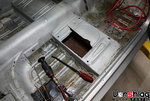
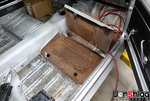
Adam knew about this issue and we agreed that we should remove these "boxed" upper shelves, inspect then clean up the metal, and build a more substantial seat base structure (like our production seat base brackets we make for a number of cars). Adam liked the idea and we got to work.
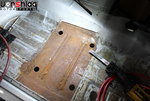
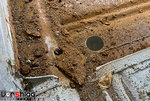
After Brad cut away the upper sections the scale and rust inside was obvious. Water can come into these seat riser cavities from the 4 access holes on the bottom, and it did. Next up Brad donned some proper PPR and got to cleaning the metal, to see if we needed to patch them or if they could be saved.
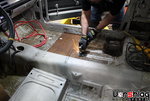
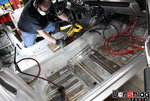
Someone in this car's past has replaced parts of these floors, and they did decent work. After Brad cleaned one side we noted that the rust was merely superficial and on the top side only. Most of the dust and scale was from the underside of the upper box piece that was tossed.
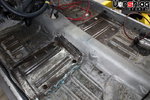
Brad logged 3.6 hours removing these parts and cleaning the metal. Now it was time to treat the bare metal and convert any remaining rust to an insert substance.
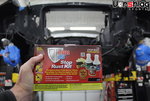
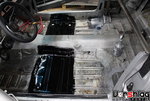
In another 1.2 hours Brad had gone through the various prep stages and added this POR15 "stop rust kit". The floors are now protected from future rust, and yes, we will be welding some structure back to this area after we design the seat bracket for this car. That will happen AFTER the cage is complete and we do a test sitting
TEST FITTING WHEELS, TIRES & FLARES
One of the main reasons we took this job was because Adam was open to doing the same things we try to add to ALL of our track builds: A lot of tire, reliable LS power, modern brakes / ABS, and modern suspension. It took a little testing, lots of pictures, but we got him there. We have been doing pictures and mockups of wheels and tires from the day it rolled in here last November through May of 2020.
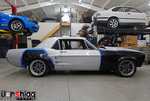
Conventional wisdom on 1st gen Mustangs is to add giant flares whenever you want more than about a 245mm tire. This car rolled in here with 17x8" fronts and 17x9" rears on 245 Michelins (that were square due to the imbalanced brakes). So I picked up a set of Maier Racing composite flares for the rear, and Adam already had their carbon front fenders - which already have a tiny bit of extra flare built into them. Mostly these are done for weight, which I showed last time.
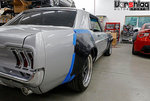
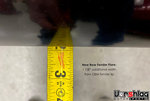
We mocked up the rear flare it is is BIG. It adds nearly 2 inches to the factory lip, and with a little more wheel room utilized inboard we could easily fit 18x12" wheels and 335s. And if you have been following our builds for the past 20 years you KNOW that I am all about the "Big Tires Matter" movement.
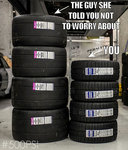
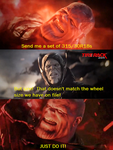
I love it when "the tires starts with a 3" - half my best car memes are about tires! There has been no limit to our "no tire is too wide" rule, not on stock 2.0L powered FR-S, not on Miatas, not on BMWs, and for sure not on Mustangs. If you cannot get the tire up to temp, DRIVE HARDER.
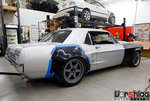
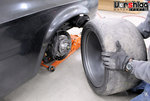
For this build a 315/30/18 was targeted as the most likely tire that could fit under the front fenders - but only after we ditched the stock front suspension. This setup "has not aged well", even with aftermarket bits and pieces to correct some of the geometry flaws. The packaging just plain SUCKS.
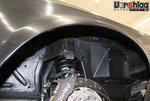
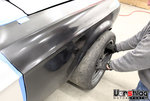
This is as far as we got with this MOMO heritage 6 wheel in 18x11" with a 315/30/18 Hoosier mounted. The stock upper spring pocket and bump stop were in the way and it pushes the wheel outside the fenders by inches. But I knew just by looking inside that fender, way back at the beginning of this project, we could make this wheel fit. Once I had the customer convinced, we cut all of that junk out of the way...
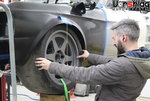
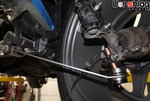
Lo and behold - the 18x11" wheel fit EASILY inside this fender when we had it mocked up with an S197 strut, temp camber plate, and temp control arm (one of two iterations we designed and built). If we wanted to push the limits we could have fit an 18x12" up front under the stock fenders, but the 18x11" wheel and 315mm tire was a noble goal - and one that could possibly be matched out back without the add-on flares. That was an early goal...
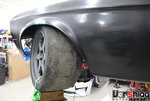
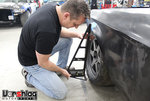
After Myles drew up the control arm for the S197 spindle we did geometry tests and wheel tests. Steering lock, ride heights, geometry changes with suspension travel, and ground clearances were all checked. The second version of the mock-up arm dialed it all in, and we will show the complete suspension installed in another update.
LS ENGINE IN, NEW TRANS CROSSMEMBER
Around March of 2020 we had the crossmember mocked up, room for the front 18x11" wheels (see above), and it was time to test an LS engine and the manual transmission. For reasons I cannot get into yet I cannot discuss or show the transmission we are using. All will be revealed at a later date.
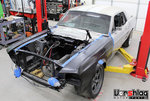
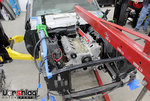
The AJE crossmember came with block side mounts, bushings and standoffs on the subframe for an LS engine. I was skeptical that we would end up using their mounts or engine location, but we figured we'd give it a test fit.
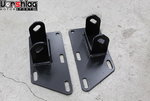
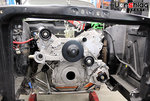
The block side plates are pretty basic but we made them work. The mock-up GEN III LS engine we had on hand was fitted with G8 / CTS-V accessories, minus the power steering pump. We were still unsure if we'd convert this car to electric steering at this point (we decided against that later - other things started to "scope creep" so we pulled this back).
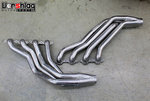
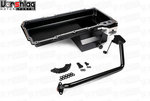
This isn't our first LS swap and we had engine swap long tube headers on hand from 5 different kits we sell, plus a few others, to test in the '67. We had several oil pans, including this one from "Summit" that has a kick out sump, trap doors, etc. We have used this pan on two other LS swap builds lately and it should work well for road course use with an LS, along with an Accusump. We tried a mid-length header first, and it didn't fit either side.
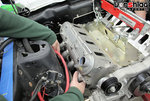
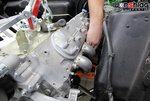
Then we tried this 1-7/8" long tube design from another swap, and it just fell right in. My wife Amy put in the passenger side and Evan the driver's side. These long tubes fit extremely well, as did the transmission, so we stopped to lock down the AJE crossmember location. I was pretty dang happy at this point - no new custom header design would be needed! FOR THE FIRST TIME EVER we already had an LS swap long tube header that could work on a completely different chassis. This never happens.
FINAL MOUNT AJE CROSSMEMBER
After the subframe was mocked up, and after positive testing and measurements with the LS engine and trans in the position set by the AJE mounts, we had a plan in place. We had test fit three LS oil pans, several intake manifolds, and fitted one of our long tube LS swap headers. The transmission we were using fit the factory shifter hole pretty well, too.
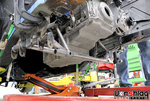
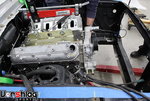
We had already adjusted the engine up and down, moved it front to back, and the only thing it did was add a lot of work - virtually no benefits. The Holley Hi Ram intake (below left) was never going to fit no matter the placement, so that tall intake was axed. And honestly it would be massive overkill for the modest 450-500 whp goal the customer had in mind. For a 2600 pound car that is going to be PLENTY of power - I suspect close to double what it came in here with.
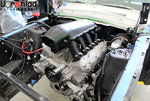
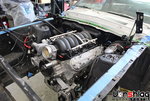
So we left the mounts that AJE added to the subframe alone, had our front axle centerline set, and even some progress on the control arms for our custom S197 front strut / spindle / brake setup. It was time to lock down the subframe position and bolt it to the frame.
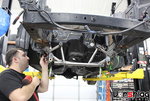
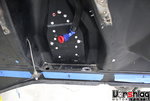
The K-member had been clamped in place for the previous tests and we had several inches of fore-aft adjustment room, but we locked it down in the position recommended by AJE. Evan marked the holes (above left) then dropped the K-member and drilled through the frame. The AJE kit comes with crush sleeves which were added and TIG welded into the frame holes (above right).
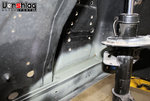
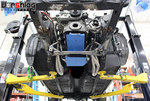
The holes / sleeves were fully welded and then sprayed with self etching primer, then the K-member was finally bolted in place. The mock up LS engine, the Summit oil pan, our long tube 1-7/8" stainless headers, and the transmission were reinstalled March 5th, 2020, right as we started to scale down hours in the shop during the lock down.
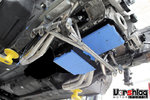
Again, apologies for the redacted images I have to use here. Getting the K-member in and the drive train installed was a good step - now we started talking about an affordable stroker 383" LS for this car, which we were putting together at HorsePower Research. We had two other track cars getting similar engines and felt it would fit the power goals, track reliability, and budget allocated to this part of the project.
CONTROL ARMS AND TRANS CROSSMEMBER BUILT
It was difficult to show the work to our customer but these images worked, and in person he could see that the transmission was appropriate for this tunnel size, the power output goals, RPM range, and both street and road course use. Again, will talk more about this when the NDA is lifted.
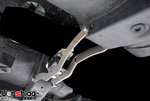
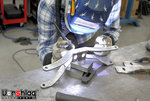
The crossmember is pretty basic, with a short span to support. We utilized a captured polyurethane Energy Suspension bushing which we have used on many LS swaps. The parts were designed in SolidWorks and cut on our CNC plasma table, as were the control arms shown below.
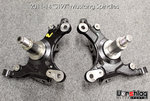
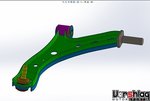
Myles and Jason worked on the control arm design based off the S197 Mustang design (2005-2014), using an S197 spindle/hub we keep on hand for design and testing purposes. Once the geometry was dialed in on the wheel testing task above, Myles ran some calculations using the OEM S197 front LCA. We bought the later S197 spindles (which upgraded from an 18mm to 19mm ball joint shaft) and Howe ball joints and threaded collars.
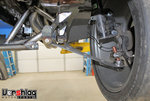
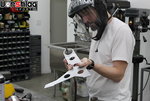
These ball joints are replaceable and the threaded Howe collars are more easily incorporated with a custom LCA design, and were used on the mock-up single plate designs to test geometry (above left). We talked about a tubular version but felt that a boxed, plate steel design would be more robust and accurately repeatable for the mirrored side-to-side design.
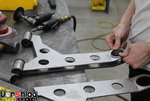
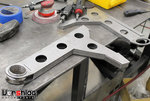
This later version had some round windows that we would later fill in with tubing to make the boxed structure stronger. Myles poured some hours into this design and the fabrication work.
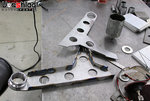
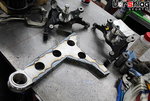
We don't do "weld pr0n" around here, because most of that Instagram welding isn't practical, and it isn't always the right way to do ti. You can look at all of our builds and won't see any pics of "stacking dimes" - because that is better left to ego posting. Proper cleaning, the right rod, adequate shield gas flow, accurate heat, and the right penetration are what we shoot for here.
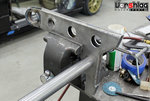
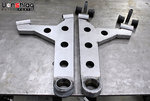
Above left you can see the tubing sections being added to the holes, for strength. Lots of tedious work went into these boxed Lower Control Arms. The control arm mounts were tubular sleeves made to fit within the AJE subframe, and to work with Whiteline bushings we ordered to fit the OD and ID needed.
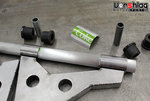
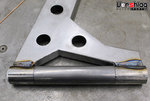
Having the sleeved mounts aligned was critical, so a couple of welding fixtures were machined to fit the ID of the tubing as well as set the spacing to mach the crossmember. We will keep these on hand, along with our CAD designs, in case we ever have a need to make these LCAs again.
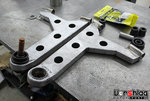
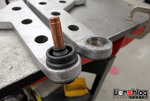
The rounded ends at the ball joint mount were "boxed" in with a final piece of steel. All of the parts were CNC cut but that doesn't make the welding and prep work any easier. After both arms were fully welded the Howe ball joints with S197 stubs were fitted with the rubber boots. No distortion and they threaded right in.
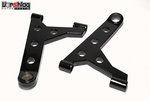
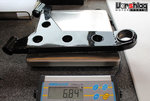
This might seem like an excess number of pictures for Lower Control Arms, but these are critical to this entire build and we built them in a new way - for us. They came out very strong, rigid, and relatively light weight. They will allow us to use a modern S197 spindle / hub / brake / ABS with a cost effective tubular crossmember from AJE - that had LS motor mounts built in.
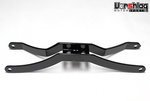
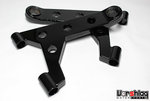
I took the LCAs and trans crossmember to have them powder coated, which wrapped up that portion of the fab work. This brought the build into early April 2020, and I will show more of these parts in a future post.
continued below
LOWER SEAT HEIGHT + FLOOR REPAIRS
Not only did this car's seat brackets lack some design aspects we like, the stock floors were pretty wobbly. The stock "boxed" sheet metal step here makes a proper racing seat install impossible without a change to the floorpan. These early Mustangs have a "riser" under the seats made of boxed sheet metal. It is flimsy, too tall, and the insides were not primed, coated or painted from Ford.


Adam knew about this issue and we agreed that we should remove these "boxed" upper shelves, inspect then clean up the metal, and build a more substantial seat base structure (like our production seat base brackets we make for a number of cars). Adam liked the idea and we got to work.


After Brad cut away the upper sections the scale and rust inside was obvious. Water can come into these seat riser cavities from the 4 access holes on the bottom, and it did. Next up Brad donned some proper PPR and got to cleaning the metal, to see if we needed to patch them or if they could be saved.


Someone in this car's past has replaced parts of these floors, and they did decent work. After Brad cleaned one side we noted that the rust was merely superficial and on the top side only. Most of the dust and scale was from the underside of the upper box piece that was tossed.

Brad logged 3.6 hours removing these parts and cleaning the metal. Now it was time to treat the bare metal and convert any remaining rust to an insert substance.


In another 1.2 hours Brad had gone through the various prep stages and added this POR15 "stop rust kit". The floors are now protected from future rust, and yes, we will be welding some structure back to this area after we design the seat bracket for this car. That will happen AFTER the cage is complete and we do a test sitting
TEST FITTING WHEELS, TIRES & FLARES
One of the main reasons we took this job was because Adam was open to doing the same things we try to add to ALL of our track builds: A lot of tire, reliable LS power, modern brakes / ABS, and modern suspension. It took a little testing, lots of pictures, but we got him there. We have been doing pictures and mockups of wheels and tires from the day it rolled in here last November through May of 2020.

Conventional wisdom on 1st gen Mustangs is to add giant flares whenever you want more than about a 245mm tire. This car rolled in here with 17x8" fronts and 17x9" rears on 245 Michelins (that were square due to the imbalanced brakes). So I picked up a set of Maier Racing composite flares for the rear, and Adam already had their carbon front fenders - which already have a tiny bit of extra flare built into them. Mostly these are done for weight, which I showed last time.


We mocked up the rear flare it is is BIG. It adds nearly 2 inches to the factory lip, and with a little more wheel room utilized inboard we could easily fit 18x12" wheels and 335s. And if you have been following our builds for the past 20 years you KNOW that I am all about the "Big Tires Matter" movement.


I love it when "the tires starts with a 3" - half my best car memes are about tires! There has been no limit to our "no tire is too wide" rule, not on stock 2.0L powered FR-S, not on Miatas, not on BMWs, and for sure not on Mustangs. If you cannot get the tire up to temp, DRIVE HARDER.


For this build a 315/30/18 was targeted as the most likely tire that could fit under the front fenders - but only after we ditched the stock front suspension. This setup "has not aged well", even with aftermarket bits and pieces to correct some of the geometry flaws. The packaging just plain SUCKS.


This is as far as we got with this MOMO heritage 6 wheel in 18x11" with a 315/30/18 Hoosier mounted. The stock upper spring pocket and bump stop were in the way and it pushes the wheel outside the fenders by inches. But I knew just by looking inside that fender, way back at the beginning of this project, we could make this wheel fit. Once I had the customer convinced, we cut all of that junk out of the way...


Lo and behold - the 18x11" wheel fit EASILY inside this fender when we had it mocked up with an S197 strut, temp camber plate, and temp control arm (one of two iterations we designed and built). If we wanted to push the limits we could have fit an 18x12" up front under the stock fenders, but the 18x11" wheel and 315mm tire was a noble goal - and one that could possibly be matched out back without the add-on flares. That was an early goal...


After Myles drew up the control arm for the S197 spindle we did geometry tests and wheel tests. Steering lock, ride heights, geometry changes with suspension travel, and ground clearances were all checked. The second version of the mock-up arm dialed it all in, and we will show the complete suspension installed in another update.
LS ENGINE IN, NEW TRANS CROSSMEMBER
Around March of 2020 we had the crossmember mocked up, room for the front 18x11" wheels (see above), and it was time to test an LS engine and the manual transmission. For reasons I cannot get into yet I cannot discuss or show the transmission we are using. All will be revealed at a later date.


The AJE crossmember came with block side mounts, bushings and standoffs on the subframe for an LS engine. I was skeptical that we would end up using their mounts or engine location, but we figured we'd give it a test fit.


The block side plates are pretty basic but we made them work. The mock-up GEN III LS engine we had on hand was fitted with G8 / CTS-V accessories, minus the power steering pump. We were still unsure if we'd convert this car to electric steering at this point (we decided against that later - other things started to "scope creep" so we pulled this back).


This isn't our first LS swap and we had engine swap long tube headers on hand from 5 different kits we sell, plus a few others, to test in the '67. We had several oil pans, including this one from "Summit" that has a kick out sump, trap doors, etc. We have used this pan on two other LS swap builds lately and it should work well for road course use with an LS, along with an Accusump. We tried a mid-length header first, and it didn't fit either side.


Then we tried this 1-7/8" long tube design from another swap, and it just fell right in. My wife Amy put in the passenger side and Evan the driver's side. These long tubes fit extremely well, as did the transmission, so we stopped to lock down the AJE crossmember location. I was pretty dang happy at this point - no new custom header design would be needed! FOR THE FIRST TIME EVER we already had an LS swap long tube header that could work on a completely different chassis. This never happens.
FINAL MOUNT AJE CROSSMEMBER
After the subframe was mocked up, and after positive testing and measurements with the LS engine and trans in the position set by the AJE mounts, we had a plan in place. We had test fit three LS oil pans, several intake manifolds, and fitted one of our long tube LS swap headers. The transmission we were using fit the factory shifter hole pretty well, too.


We had already adjusted the engine up and down, moved it front to back, and the only thing it did was add a lot of work - virtually no benefits. The Holley Hi Ram intake (below left) was never going to fit no matter the placement, so that tall intake was axed. And honestly it would be massive overkill for the modest 450-500 whp goal the customer had in mind. For a 2600 pound car that is going to be PLENTY of power - I suspect close to double what it came in here with.


So we left the mounts that AJE added to the subframe alone, had our front axle centerline set, and even some progress on the control arms for our custom S197 front strut / spindle / brake setup. It was time to lock down the subframe position and bolt it to the frame.


The K-member had been clamped in place for the previous tests and we had several inches of fore-aft adjustment room, but we locked it down in the position recommended by AJE. Evan marked the holes (above left) then dropped the K-member and drilled through the frame. The AJE kit comes with crush sleeves which were added and TIG welded into the frame holes (above right).


The holes / sleeves were fully welded and then sprayed with self etching primer, then the K-member was finally bolted in place. The mock up LS engine, the Summit oil pan, our long tube 1-7/8" stainless headers, and the transmission were reinstalled March 5th, 2020, right as we started to scale down hours in the shop during the lock down.

Again, apologies for the redacted images I have to use here. Getting the K-member in and the drive train installed was a good step - now we started talking about an affordable stroker 383" LS for this car, which we were putting together at HorsePower Research. We had two other track cars getting similar engines and felt it would fit the power goals, track reliability, and budget allocated to this part of the project.
CONTROL ARMS AND TRANS CROSSMEMBER BUILT
It was difficult to show the work to our customer but these images worked, and in person he could see that the transmission was appropriate for this tunnel size, the power output goals, RPM range, and both street and road course use. Again, will talk more about this when the NDA is lifted.


The crossmember is pretty basic, with a short span to support. We utilized a captured polyurethane Energy Suspension bushing which we have used on many LS swaps. The parts were designed in SolidWorks and cut on our CNC plasma table, as were the control arms shown below.


Myles and Jason worked on the control arm design based off the S197 Mustang design (2005-2014), using an S197 spindle/hub we keep on hand for design and testing purposes. Once the geometry was dialed in on the wheel testing task above, Myles ran some calculations using the OEM S197 front LCA. We bought the later S197 spindles (which upgraded from an 18mm to 19mm ball joint shaft) and Howe ball joints and threaded collars.


These ball joints are replaceable and the threaded Howe collars are more easily incorporated with a custom LCA design, and were used on the mock-up single plate designs to test geometry (above left). We talked about a tubular version but felt that a boxed, plate steel design would be more robust and accurately repeatable for the mirrored side-to-side design.


This later version had some round windows that we would later fill in with tubing to make the boxed structure stronger. Myles poured some hours into this design and the fabrication work.


We don't do "weld pr0n" around here, because most of that Instagram welding isn't practical, and it isn't always the right way to do ti. You can look at all of our builds and won't see any pics of "stacking dimes" - because that is better left to ego posting. Proper cleaning, the right rod, adequate shield gas flow, accurate heat, and the right penetration are what we shoot for here.


Above left you can see the tubing sections being added to the holes, for strength. Lots of tedious work went into these boxed Lower Control Arms. The control arm mounts were tubular sleeves made to fit within the AJE subframe, and to work with Whiteline bushings we ordered to fit the OD and ID needed.


Having the sleeved mounts aligned was critical, so a couple of welding fixtures were machined to fit the ID of the tubing as well as set the spacing to mach the crossmember. We will keep these on hand, along with our CAD designs, in case we ever have a need to make these LCAs again.


The rounded ends at the ball joint mount were "boxed" in with a final piece of steel. All of the parts were CNC cut but that doesn't make the welding and prep work any easier. After both arms were fully welded the Howe ball joints with S197 stubs were fitted with the rubber boots. No distortion and they threaded right in.


This might seem like an excess number of pictures for Lower Control Arms, but these are critical to this entire build and we built them in a new way - for us. They came out very strong, rigid, and relatively light weight. They will allow us to use a modern S197 spindle / hub / brake / ABS with a cost effective tubular crossmember from AJE - that had LS motor mounts built in.


I took the LCAs and trans crossmember to have them powder coated, which wrapped up that portion of the fab work. This brought the build into early April 2020, and I will show more of these parts in a future post.
continued below
- Thread starter
- #33
continued from above
COMPOSITE DOORS
The dreaded Scope Creep started to happen here. When this '67 Mustang project came in it was still a "street car that could occasionally do track events". It had a 4-point roll bar, full interior, and working air con. As the project progressed the owner quickly re-focused his already listed safety goals to match the increased performance we were adding. To mate the power output of the LS7 the safety goals went up to match. Instead of a reconfigured 4-point roll bar it was time for a proper roll cage, and by then the car became a dedicated track car "that can be driven on the street".
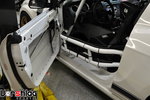
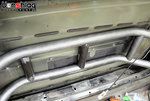
After the cage had begun we talked about door bar options - a simple "X" that allows for an interior door panel, or a more roomy NASCAR style door bar, as shown above. After seeing the difference in person, and noting the lateral room gained when we push the bars out to the outer skin of the door, Adam wanted to go ahead and use NASCAR style door bars. That means ditching the door panels, the door windows, and the interior.
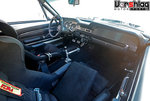
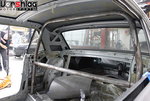
We asked him several times if he was SURE that's what he wanted - because going this route shrinks the number of people willing to buy any car when it is completed. Caged race cars are harder to sell than street cars with some tasteful mods. But as you can see by the other mods that have been added as we went along, this has turned into a more serious track build. And the door bars will add a lot of side impact protection and extra room for both the driver and passenger.
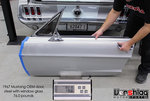
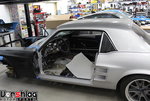
Adding safety usually means adding WEIGHT - which is always the enemy of speed. The OEM steel doors are always heavy when chock full of crash beams, window mechanisms, glass, and speakers. These were no different at 76.0 pounds each. So when he asked for NASCAR door bars, the need for OEM door impact protection went away - so I suggested these cost effective composite doors from VFN.
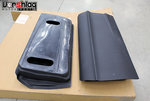
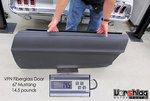
These fiberglass doors were purchased and weighed in at a paltry 14.5 pounds - and that's before we clearance them for the cage's door bars. This weight savings will be about a 123 pound drop, which should offset the weight gain of the full cage over the 4-point (and then some).
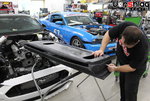
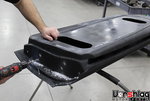
We have used VFN body parts before and they fall in at the more affordable end of the spectrum of quality, lightweight composites. Way better than cheap import stuff, but not quite Motorsports Dry Carbon level. Evan checked then marked the mounting holes (dimpled in the mold) and drilled them for the door hinges. We will use the OEM hinges without the return springs. Evan made some templates from these hinge mount holes, then Myles CNC cut some backing steel plates for "doublers" that go on the inside of the door structure.
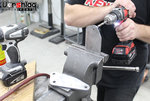
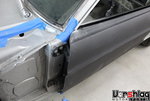
Evan then tack welded nuts to these plates, which are riveted to the door structure. Makes installation and removal a breeze and strengthens the part of the door that sees the highest loads - the hinge points.
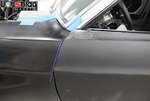
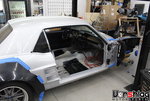
A little time was spent "fitting" the doors, but with aftermarket composite front fenders and composite doors from another company, they don't "play nice together". As is the case with some composite parts, both the Maier Racing composite fenders and VFN doors are made a little "long" so you can trim them to fit. We are not a body shop, so I will deliver the chassis to our painter (as soon as the suspension is done enough to let it roll into my trailer) and have him adjust all of the panels on the front of the car, from the doors forward.
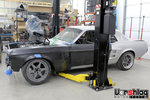
The body shop can trim the doors and fenders to have a better fit so we can open/close the doors. Until then we will either have the doors -or- the front fenders on, depending on what we are doing. You won't see them both installed from here until they are properly fitted.
LS7 CRATE ENGINE + TRANS INSTALLED
As we were wrapping up one of the first in a series of "affordable" LS road race engines at HPR, we had a good grasp on the price and output numbers. This was to be a cathedral port, aluminum block, 383" LS stroker, wet sump road race engine - I gave the pricing to give Adam. I had one of these being built for my LS550 project and we could see a 450-550 whp power range depending on the cam, intake, and some other aspects.
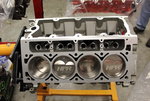
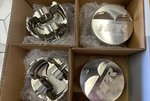
This would take more than 2 months to build, due to the backlog of engines in process at HPR, plus some added delays due to Covid-19. This 383" long block would still need: intake manifold, fuel rail, injectors, throttle body, ignition coils, the Summit road race oil pan we talked about, water pump, pulley, flywheel and clutch - but it was still a very good package price. It was until he went and found these GM crate LS7 dry sump 525 hp 2015 Z/28 spec engines on "Coronavirus Sale" at $10,900...?! I researched this deal, which seemed unbelievable, but it was true.
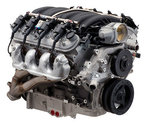
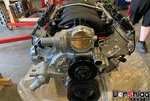
I couldn't get the HPR 383 LS6 down to that price level after I added in all of the extras that the crate engines come with, not to mention this has the LS7 dry sump oil pan, extended snout crank, and 2 stage oil pump. Just the bare LS7 block alone costs $3800 - GM must have needed some quick cash to slash these LS7s down to this price! These are the later 2015 spec so they have improved titanium rods, better valves, a bigger oil pan, and several other updates. We're not going to touch the engines internals or cam, and will even use the included flywheel and clutch. Saves time and money and adds displacement. And he can just tell the Ford Faithful it is a 427" V8... they can think its an "FE" series Ford Big block if they want, as long as he doesn't open the hood.
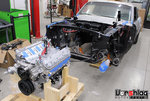
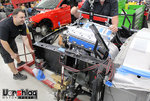
Of course getting a complete, dressed crate engine will save time on this build. After we unloaded the engine from the crate, Evan stripped off the intake and coils, so we don't damage them when installing the engine into the car. Brad and Evan put the long block and bellhousing in without drama using our engine tilter and engine hoist.
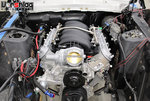
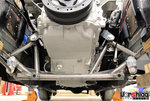
I was a little worried that the 2015 Z/28 oil pan might have some clearance issues but that was not the case - fit by a large margin. These LS7 dry sump engines still have a lower oil sump, so we can't lower this any more than we could our mock-up engine. Evan reinstalled the intake and coils with the engine back in the car for the last time before it fires up.
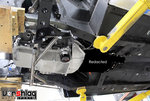
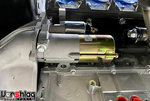
After testing the TOB engagement & input shaft depth, the transmission was fitted, as were the hydraulic Throw Out Bearing slave line and remote bleeder, with a quick connect on the pressure line. Had the pressure line made to fit the hydraulic clutch master cylinder Adam had installed for his T5 before. We then installed a new starter. This thing is ready to plumb, wire and fire!
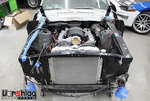
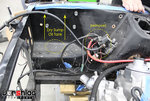
We still have work to do - with the engine and aluminum radiator in place we can route things like the Cold Air Intake, pick a filter, and find a place for the dry sump settling tank. We have discussed the EFI system and digital dash options with the customer and that is on order, so it could be running in a matter of weeks.
WHAT'S NEXT?
I had a whole section on the fuel cell, but I will show that next time. It is a beautiful piece of engineering, with an internal surge tank. That was all assembled and mounted last week.
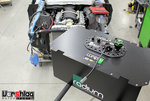
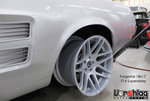
We also have the 18x11" Forgestar F14 Super Deep wheels on hand already. A bunch of new parts have arrived for the front suspension: S197 spindles, front hubs with ARP studs, the custom control arms we built, the 14" diameter 4 piston Brembo brakes, and the MCS TT2 doubles arrive later today. The custom camber plate & welded on strut top design are wrapping up as well.
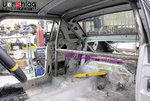
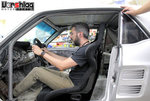
This week we have made some good progress on the cage, and we were test fitting seats with Myles (5'11") showing how much head room we gained to the upper door bars with the lower seat mounting. This post is already running long so I'm going to call that good until next time - should have another tech filled post showing more progress on this car soon.
Thanks for reading,
Terry @ Vorshlag
COMPOSITE DOORS
The dreaded Scope Creep started to happen here. When this '67 Mustang project came in it was still a "street car that could occasionally do track events". It had a 4-point roll bar, full interior, and working air con. As the project progressed the owner quickly re-focused his already listed safety goals to match the increased performance we were adding. To mate the power output of the LS7 the safety goals went up to match. Instead of a reconfigured 4-point roll bar it was time for a proper roll cage, and by then the car became a dedicated track car "that can be driven on the street".


After the cage had begun we talked about door bar options - a simple "X" that allows for an interior door panel, or a more roomy NASCAR style door bar, as shown above. After seeing the difference in person, and noting the lateral room gained when we push the bars out to the outer skin of the door, Adam wanted to go ahead and use NASCAR style door bars. That means ditching the door panels, the door windows, and the interior.


We asked him several times if he was SURE that's what he wanted - because going this route shrinks the number of people willing to buy any car when it is completed. Caged race cars are harder to sell than street cars with some tasteful mods. But as you can see by the other mods that have been added as we went along, this has turned into a more serious track build. And the door bars will add a lot of side impact protection and extra room for both the driver and passenger.


Adding safety usually means adding WEIGHT - which is always the enemy of speed. The OEM steel doors are always heavy when chock full of crash beams, window mechanisms, glass, and speakers. These were no different at 76.0 pounds each. So when he asked for NASCAR door bars, the need for OEM door impact protection went away - so I suggested these cost effective composite doors from VFN.


These fiberglass doors were purchased and weighed in at a paltry 14.5 pounds - and that's before we clearance them for the cage's door bars. This weight savings will be about a 123 pound drop, which should offset the weight gain of the full cage over the 4-point (and then some).


We have used VFN body parts before and they fall in at the more affordable end of the spectrum of quality, lightweight composites. Way better than cheap import stuff, but not quite Motorsports Dry Carbon level. Evan checked then marked the mounting holes (dimpled in the mold) and drilled them for the door hinges. We will use the OEM hinges without the return springs. Evan made some templates from these hinge mount holes, then Myles CNC cut some backing steel plates for "doublers" that go on the inside of the door structure.


Evan then tack welded nuts to these plates, which are riveted to the door structure. Makes installation and removal a breeze and strengthens the part of the door that sees the highest loads - the hinge points.


A little time was spent "fitting" the doors, but with aftermarket composite front fenders and composite doors from another company, they don't "play nice together". As is the case with some composite parts, both the Maier Racing composite fenders and VFN doors are made a little "long" so you can trim them to fit. We are not a body shop, so I will deliver the chassis to our painter (as soon as the suspension is done enough to let it roll into my trailer) and have him adjust all of the panels on the front of the car, from the doors forward.

The body shop can trim the doors and fenders to have a better fit so we can open/close the doors. Until then we will either have the doors -or- the front fenders on, depending on what we are doing. You won't see them both installed from here until they are properly fitted.
LS7 CRATE ENGINE + TRANS INSTALLED
As we were wrapping up one of the first in a series of "affordable" LS road race engines at HPR, we had a good grasp on the price and output numbers. This was to be a cathedral port, aluminum block, 383" LS stroker, wet sump road race engine - I gave the pricing to give Adam. I had one of these being built for my LS550 project and we could see a 450-550 whp power range depending on the cam, intake, and some other aspects.


This would take more than 2 months to build, due to the backlog of engines in process at HPR, plus some added delays due to Covid-19. This 383" long block would still need: intake manifold, fuel rail, injectors, throttle body, ignition coils, the Summit road race oil pan we talked about, water pump, pulley, flywheel and clutch - but it was still a very good package price. It was until he went and found these GM crate LS7 dry sump 525 hp 2015 Z/28 spec engines on "Coronavirus Sale" at $10,900...?! I researched this deal, which seemed unbelievable, but it was true.


I couldn't get the HPR 383 LS6 down to that price level after I added in all of the extras that the crate engines come with, not to mention this has the LS7 dry sump oil pan, extended snout crank, and 2 stage oil pump. Just the bare LS7 block alone costs $3800 - GM must have needed some quick cash to slash these LS7s down to this price! These are the later 2015 spec so they have improved titanium rods, better valves, a bigger oil pan, and several other updates. We're not going to touch the engines internals or cam, and will even use the included flywheel and clutch. Saves time and money and adds displacement. And he can just tell the Ford Faithful it is a 427" V8... they can think its an "FE" series Ford Big block if they want, as long as he doesn't open the hood.


Of course getting a complete, dressed crate engine will save time on this build. After we unloaded the engine from the crate, Evan stripped off the intake and coils, so we don't damage them when installing the engine into the car. Brad and Evan put the long block and bellhousing in without drama using our engine tilter and engine hoist.


I was a little worried that the 2015 Z/28 oil pan might have some clearance issues but that was not the case - fit by a large margin. These LS7 dry sump engines still have a lower oil sump, so we can't lower this any more than we could our mock-up engine. Evan reinstalled the intake and coils with the engine back in the car for the last time before it fires up.


After testing the TOB engagement & input shaft depth, the transmission was fitted, as were the hydraulic Throw Out Bearing slave line and remote bleeder, with a quick connect on the pressure line. Had the pressure line made to fit the hydraulic clutch master cylinder Adam had installed for his T5 before. We then installed a new starter. This thing is ready to plumb, wire and fire!


We still have work to do - with the engine and aluminum radiator in place we can route things like the Cold Air Intake, pick a filter, and find a place for the dry sump settling tank. We have discussed the EFI system and digital dash options with the customer and that is on order, so it could be running in a matter of weeks.
WHAT'S NEXT?
I had a whole section on the fuel cell, but I will show that next time. It is a beautiful piece of engineering, with an internal surge tank. That was all assembled and mounted last week.


We also have the 18x11" Forgestar F14 Super Deep wheels on hand already. A bunch of new parts have arrived for the front suspension: S197 spindles, front hubs with ARP studs, the custom control arms we built, the 14" diameter 4 piston Brembo brakes, and the MCS TT2 doubles arrive later today. The custom camber plate & welded on strut top design are wrapping up as well.


This week we have made some good progress on the cage, and we were test fitting seats with Myles (5'11") showing how much head room we gained to the upper door bars with the lower seat mounting. This post is already running long so I'm going to call that good until next time - should have another tech filled post showing more progress on this car soon.
Thanks for reading,
Terry @ Vorshlag
- Thread starter
- #34
Project Update for January 30th, 2021: Since our last post in this thread in May of 2020 we have finished a huge chunk of work to this Mustang. After we got to a point where we needed fenders and hood to fit things, we loaded up the car and I trailered it to the painter to have bodywork fitted (October 2020), and while there, things snowballed into a lot of body work - but with amazing results. The car came back from the painter on Christmas Eve 2020, looking very complete and ready for paint.
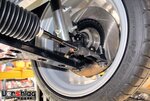
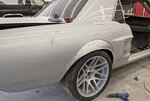
From May to September we completed a ton of tasks: strut towers were modified and reinforced, initial camber plates built, spindles and brakes installed, steering completed, and the front suspension was wrapped up. A power steering pump was modified and installed, a bit of cage work completed, the 18x11" wheels and 315mm tires were fitted, a fuel cell was ordered and mounted, the entire fuel system was plumbed, and the Holley EFI system was wired. Long tube headers fitted, cooling system started, and hood hinges modified. Tremec has since released their TKX, so I can show that now. At the body shop a new hood was installed, the front doors and fenders were fitted, the rear wheels flared, a carbon lower air dam went on, and the whole body was blocked, sanded, adjusted, sanded some more, and primed.
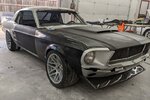
This Mustang is coming along nicely, as you can see in the image at the body shop, above. We have had some personnel changes in the months form May to December, and have found a great fabricator in Zach, who will wrap up a lot of the remaining work in 2021. Brad spent some months finishing up our shop construction, and we now have a more efficient area to resume work. Lots to cover on this projects so let's get started!
FRONT SUSPENSION WORK
Myles and Jason had been working on the front suspension for quite some time, and the front control arms were designed around the stock shock tower placement (which would be heavily modified) and a 2011-14 Mustang GT "S197" spindle, hub and brake.
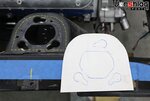
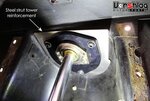
Evan took the the templates and we scanned those in to make some CNC cut plates that fit inside the towers and key off of certain stock locations. The goal is to make something we can reproduce in the future - which could be installed by others in their own home garage. We tooled up a temporary camber plate and strut to get some dimensions, then Jason drew up custom front struts which we had built by Motion Control Suspension (MCS) out of Georgia.
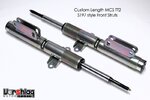
These double adjustable, S197 style MCS front struts arrived May 29th, 2020. Things started to happen more quickly after that point.
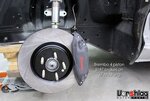
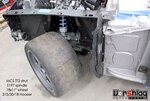
With the temporary strut tower and camber plate installed, brand new 14" rotors, 4 piston Brembo calipers, ARP stud equipped S197 hubs and new S197 spindle were installed along with our custom lower control arms in the AJE cradle. Evan mocked up one of my 18x11" wheels and 315/30/18 Hoosier R7s on the front and we started some geometry checks.
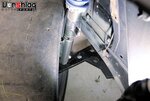
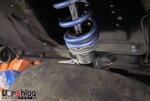
Juggling with wheel spacers we took these S550 fitment front wheels and were able to tuck them within 5mm of the strut, which we do to maximize front wheel room. Steering angle looked excellent - lots of room and lots of total steering lock possible. Time to lower things down and get the car off the front dolly that it had been bolted to for many months.
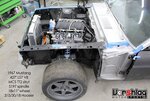
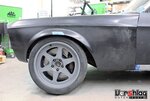
Seeing this really got everyone fired up. The big 11" wide wheel, 315mm Hoosier, the Brembo calipers and meaty rotor in there... wow. With the front fender installed we realized we had plenty of room - these massive wheels might have fit with the stock fenders, but they were long gone. Time to get to work on the final strut tower design with the suspension in place, and initial camber numbers in hand.
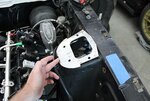
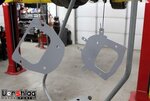
The initial setup had too much negative camber so the strut tower was built to take away some of that, but still give plenty of adjustment range. We also designed this to give ample positive caster adjustment.
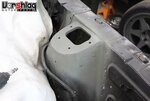
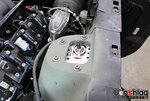
As the strut towers were reconfigured to take full suspension loads and not just shock loads, the steel plates we CNC cut were welded in and massively reinforced the whole area. A well anchored strut tower brace will also be designed and added. A temporary CNC plasma cut camber plate was cut and installed, but the final version will be CNC machined from aluminum and use counter sunk (flush) bolts for the caster adjustment.
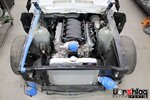
By the end of June we had strut towers modified, the MCS struts / brakes / hubs installed, and both of my 18x11" MOMO Heritage 6 wheels and 315mm Hoosiers installed. The car was on the ground and rolling again - the dolly that had been holding up the front end for months was taken apart and put away.
FENDER ISSUES + FORGESTAR 18x11" WHEELS
We had great luck fitting the VFN fiberglass doors, as we know this brand and have used it well on other cars. But the Maier fenders really fit very poorly, and the side-to-side differences were quite astonishing. The fender openings were off by 3/4" side to side! We cannot install either fender with the doors installed, because they are made much longer than the stock fenders. We had marked center on both sides and "split the difference" for our front axle centerline.
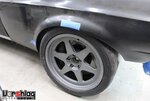
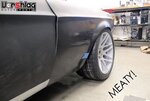
Making these fenders fit with a Maier supplied hood would end up taking nearly 2 weeks at the body shop, who had nothing good to say about the quality of fit of these parts. They had to modify the arches to sort of line up side to side and shorten the rear lengths to fit the doors.
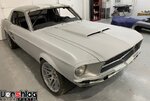
To get the fender tops and hood to line up took DAYS of work and a LOT of fiberglass filler - and these are parts from the same company. Lots of time was spent sanding, fitting, and blocking to get the body lines to look like this. Many thousands of dollars in bodywork to get this level of fit. Just be warned - not all aftermarket composite bodywork is made the same. Don't let a "name" fool you into thinking these parts actually fit well. They don't, not without a LOT of work.
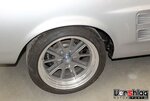
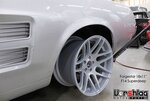
Adam's Mustang rolled in here on some Shelby replica wheels in 17x8" front and 17x9" rear with 245mm Michelins. The tires were flat spotted badly in the front, due to some brake components made by Wilwood that had what appears to be horrible front to rear balance. We're fixing that with modern Brembo brakes and ABS, but the little bitty wheel and tire package is getting a major re-do also. This 18x11" Forgestar F14 Super Deep wheel set was ordered for another car in the shop and it just so happened to be a near perfect fit for Adam's Mustang.
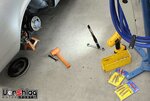
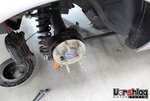
This happened at the perfect time for Adam - a set of wheels that fit his car arrived in the right size, without the 4+ month wait we usually have to sit thru for their wheels. All it took was some longer wheel studs in the rear and a bit of a spacer out back. These 3" ARP studs went in place of the short 1-1/2" studs in the Currie axles out back.
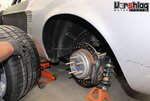
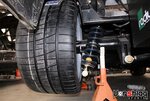
Brad and Evan dialed in the spacer thickness needed until I liked the inboard wheel room to the chassis, above. We can get away with 1/2" of room there due to the Watts Link and 3-link rear suspension under the car.
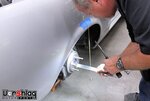
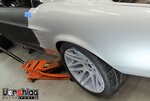
Brad noted that the axle was not centered, so he checked and adjusted the axle to have the same side to side measurement. Then a set of 315/30/18 Rival-S 1.5 tires were fitted to the wheels and they looked great on the car. The outer fender lips would need a little massaging, but no "mega flare" work would be needed.
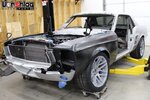
The fronts bolted on with no spacer and no tricks. These were the perfect offset, astonishing. Sometimes you get lucky. The spacer setup on the rear is very minor and will allow Adam to rotate the same wheels front to back, for an ideal track setup. The deep spoke offsets look REALLY good on this little coupe, too! So by the first week of July 2020 we had the final wheels and tires on the car, which was a big step.
FUEL TANK REPLACEMENT & TRUNK WORK
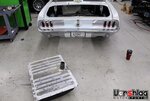
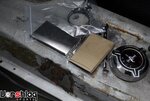
Evan removed the fuel tank in early May to do some rust repair in the trunk. Just a small section at the right side, but too close to the tank to do without removal. We also were looking at a solution to properly feed a dry sump 427" LS7 on track with big fat 315mm tires we would soon install.
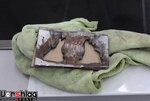
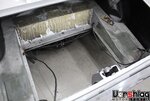
Evan got the rot repair done, quickly and beautifully. Now it was time to talk about options. After researching a few replacement fuel tanks, looking at remote surge tanks, and offering up a fuel cell option - Adam went with this modular 15 gallon Radium Engineering fuel cell with integrated surge tank, pumps, and FIA certs.
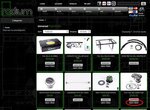
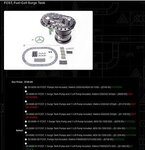
This was a relatively new offering from Radium Engineering, available piece by piece or as a complete fuel cell, with lots of options.
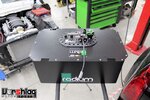
This is the real deal, and comes in 5, 10, and 15 gallon versions. I only wish they made a 20 gallon, then we'd have them in several road race cars. This is a full containment can, Kevlar bladder, foam, the works. We ordered this 15 gallon version with the "FCST" upper, fuel level pickup, filler neck and cap, and supplied our own pumps.
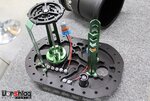
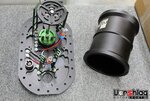
The best part of this complete fuel cell system is the integral "Fuel Cell Surge Tank" portion of the tank. These integral surge tank tops can be ordered separately for other fuel cells, and they make variable depth pickups and fuel level sensors. Evan lobbied hard for this, as he has one in his own race car. This is a thing of beauty and precludes the need for an external surge tank.
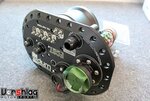
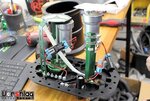
All of the wiring connections are on the top, as are the filler neck, rollover valve, and feed/return lines. Evan added Walbro 430 pumps for the lift pump (at right, with the sock) and the internal surge tank (which can take 1, 2, or 3 pumps). Then the internal surge can (black part shown below left) was added and it was bolted into the Radium cell.
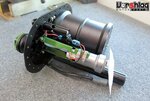
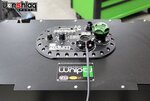
All of the internal wiring is connected and ready for plumbing at this point - it went together quickly. You can even order this with pumps and then they pre-assemble the whole thing. Very slick system.
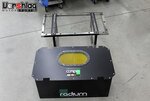
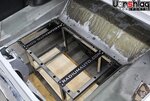
We ordered this with the optional mounting cage from Radium. Sure, we could have built this, but not likely for as little as they charge. The work now was making this fit the larger opening of the stock tank. We experimented with front to back as well as height adjustment then Evan started making the pieces to fit that spot.
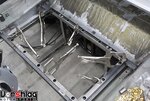
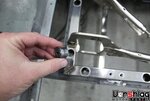
With some steel angle tack welded in place and load spreader plates at the rear frame rails, the mounting cage was clamped in place. Then some a drill fixture was made from CNC machined bushings we use for something else.
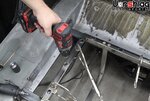
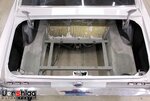
That allowed him to perfectly drill these smaller holes though the Radium cage and into his angle structure. The angle structure was then finish welded and primed in the car.
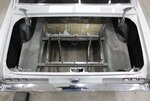
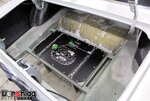
The final install of the cage (above left) uses hardware from the steel can of the fuel cell (above right) and bolts into threaded inserts through the cage and into the steel angle mounting structure Evan added.
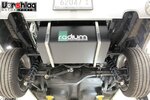
This ended up being one of the slickest - and quickest - fuel cell installs we have ever done. This won't be the last Radium Engineering modular fuel cells we install, that's for sure.
DRIVETRAIN REVEAL
Some of this has been known before - this car came in here with a built Currie Ford 9" rear axle (below left) and we added the crate 525hp LS7 (below right).
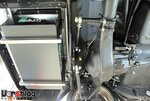
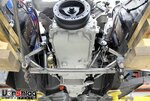
One thing I was under NDA not to disclose until November 2020 was the Tremec TKX 5 speed manual transmission, which we got early due to our testing relationship with Tremec.
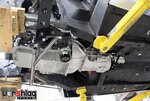
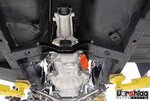
This is a clean slate redesign of the old TKO transmission with modern 3-piece synchros, carbon blocker rings, a new case, new everything. It is still very compact and lighter than any T56 Magnum, which would have taken tunnel surgery work to make fit. As it is the TKX was a super easy install. We did zero cutting, just made the transmission crossmember shown. That's it. It bolts right in.
continued below


From May to September we completed a ton of tasks: strut towers were modified and reinforced, initial camber plates built, spindles and brakes installed, steering completed, and the front suspension was wrapped up. A power steering pump was modified and installed, a bit of cage work completed, the 18x11" wheels and 315mm tires were fitted, a fuel cell was ordered and mounted, the entire fuel system was plumbed, and the Holley EFI system was wired. Long tube headers fitted, cooling system started, and hood hinges modified. Tremec has since released their TKX, so I can show that now. At the body shop a new hood was installed, the front doors and fenders were fitted, the rear wheels flared, a carbon lower air dam went on, and the whole body was blocked, sanded, adjusted, sanded some more, and primed.

This Mustang is coming along nicely, as you can see in the image at the body shop, above. We have had some personnel changes in the months form May to December, and have found a great fabricator in Zach, who will wrap up a lot of the remaining work in 2021. Brad spent some months finishing up our shop construction, and we now have a more efficient area to resume work. Lots to cover on this projects so let's get started!
FRONT SUSPENSION WORK
Myles and Jason had been working on the front suspension for quite some time, and the front control arms were designed around the stock shock tower placement (which would be heavily modified) and a 2011-14 Mustang GT "S197" spindle, hub and brake.


Evan took the the templates and we scanned those in to make some CNC cut plates that fit inside the towers and key off of certain stock locations. The goal is to make something we can reproduce in the future - which could be installed by others in their own home garage. We tooled up a temporary camber plate and strut to get some dimensions, then Jason drew up custom front struts which we had built by Motion Control Suspension (MCS) out of Georgia.

These double adjustable, S197 style MCS front struts arrived May 29th, 2020. Things started to happen more quickly after that point.


With the temporary strut tower and camber plate installed, brand new 14" rotors, 4 piston Brembo calipers, ARP stud equipped S197 hubs and new S197 spindle were installed along with our custom lower control arms in the AJE cradle. Evan mocked up one of my 18x11" wheels and 315/30/18 Hoosier R7s on the front and we started some geometry checks.


Juggling with wheel spacers we took these S550 fitment front wheels and were able to tuck them within 5mm of the strut, which we do to maximize front wheel room. Steering angle looked excellent - lots of room and lots of total steering lock possible. Time to lower things down and get the car off the front dolly that it had been bolted to for many months.


Seeing this really got everyone fired up. The big 11" wide wheel, 315mm Hoosier, the Brembo calipers and meaty rotor in there... wow. With the front fender installed we realized we had plenty of room - these massive wheels might have fit with the stock fenders, but they were long gone. Time to get to work on the final strut tower design with the suspension in place, and initial camber numbers in hand.


The initial setup had too much negative camber so the strut tower was built to take away some of that, but still give plenty of adjustment range. We also designed this to give ample positive caster adjustment.


As the strut towers were reconfigured to take full suspension loads and not just shock loads, the steel plates we CNC cut were welded in and massively reinforced the whole area. A well anchored strut tower brace will also be designed and added. A temporary CNC plasma cut camber plate was cut and installed, but the final version will be CNC machined from aluminum and use counter sunk (flush) bolts for the caster adjustment.

By the end of June we had strut towers modified, the MCS struts / brakes / hubs installed, and both of my 18x11" MOMO Heritage 6 wheels and 315mm Hoosiers installed. The car was on the ground and rolling again - the dolly that had been holding up the front end for months was taken apart and put away.
FENDER ISSUES + FORGESTAR 18x11" WHEELS
We had great luck fitting the VFN fiberglass doors, as we know this brand and have used it well on other cars. But the Maier fenders really fit very poorly, and the side-to-side differences were quite astonishing. The fender openings were off by 3/4" side to side! We cannot install either fender with the doors installed, because they are made much longer than the stock fenders. We had marked center on both sides and "split the difference" for our front axle centerline.


Making these fenders fit with a Maier supplied hood would end up taking nearly 2 weeks at the body shop, who had nothing good to say about the quality of fit of these parts. They had to modify the arches to sort of line up side to side and shorten the rear lengths to fit the doors.

To get the fender tops and hood to line up took DAYS of work and a LOT of fiberglass filler - and these are parts from the same company. Lots of time was spent sanding, fitting, and blocking to get the body lines to look like this. Many thousands of dollars in bodywork to get this level of fit. Just be warned - not all aftermarket composite bodywork is made the same. Don't let a "name" fool you into thinking these parts actually fit well. They don't, not without a LOT of work.


Adam's Mustang rolled in here on some Shelby replica wheels in 17x8" front and 17x9" rear with 245mm Michelins. The tires were flat spotted badly in the front, due to some brake components made by Wilwood that had what appears to be horrible front to rear balance. We're fixing that with modern Brembo brakes and ABS, but the little bitty wheel and tire package is getting a major re-do also. This 18x11" Forgestar F14 Super Deep wheel set was ordered for another car in the shop and it just so happened to be a near perfect fit for Adam's Mustang.


This happened at the perfect time for Adam - a set of wheels that fit his car arrived in the right size, without the 4+ month wait we usually have to sit thru for their wheels. All it took was some longer wheel studs in the rear and a bit of a spacer out back. These 3" ARP studs went in place of the short 1-1/2" studs in the Currie axles out back.


Brad and Evan dialed in the spacer thickness needed until I liked the inboard wheel room to the chassis, above. We can get away with 1/2" of room there due to the Watts Link and 3-link rear suspension under the car.


Brad noted that the axle was not centered, so he checked and adjusted the axle to have the same side to side measurement. Then a set of 315/30/18 Rival-S 1.5 tires were fitted to the wheels and they looked great on the car. The outer fender lips would need a little massaging, but no "mega flare" work would be needed.

The fronts bolted on with no spacer and no tricks. These were the perfect offset, astonishing. Sometimes you get lucky. The spacer setup on the rear is very minor and will allow Adam to rotate the same wheels front to back, for an ideal track setup. The deep spoke offsets look REALLY good on this little coupe, too! So by the first week of July 2020 we had the final wheels and tires on the car, which was a big step.
FUEL TANK REPLACEMENT & TRUNK WORK


Evan removed the fuel tank in early May to do some rust repair in the trunk. Just a small section at the right side, but too close to the tank to do without removal. We also were looking at a solution to properly feed a dry sump 427" LS7 on track with big fat 315mm tires we would soon install.


Evan got the rot repair done, quickly and beautifully. Now it was time to talk about options. After researching a few replacement fuel tanks, looking at remote surge tanks, and offering up a fuel cell option - Adam went with this modular 15 gallon Radium Engineering fuel cell with integrated surge tank, pumps, and FIA certs.


This was a relatively new offering from Radium Engineering, available piece by piece or as a complete fuel cell, with lots of options.

This is the real deal, and comes in 5, 10, and 15 gallon versions. I only wish they made a 20 gallon, then we'd have them in several road race cars. This is a full containment can, Kevlar bladder, foam, the works. We ordered this 15 gallon version with the "FCST" upper, fuel level pickup, filler neck and cap, and supplied our own pumps.


The best part of this complete fuel cell system is the integral "Fuel Cell Surge Tank" portion of the tank. These integral surge tank tops can be ordered separately for other fuel cells, and they make variable depth pickups and fuel level sensors. Evan lobbied hard for this, as he has one in his own race car. This is a thing of beauty and precludes the need for an external surge tank.


All of the wiring connections are on the top, as are the filler neck, rollover valve, and feed/return lines. Evan added Walbro 430 pumps for the lift pump (at right, with the sock) and the internal surge tank (which can take 1, 2, or 3 pumps). Then the internal surge can (black part shown below left) was added and it was bolted into the Radium cell.


All of the internal wiring is connected and ready for plumbing at this point - it went together quickly. You can even order this with pumps and then they pre-assemble the whole thing. Very slick system.


We ordered this with the optional mounting cage from Radium. Sure, we could have built this, but not likely for as little as they charge. The work now was making this fit the larger opening of the stock tank. We experimented with front to back as well as height adjustment then Evan started making the pieces to fit that spot.


With some steel angle tack welded in place and load spreader plates at the rear frame rails, the mounting cage was clamped in place. Then some a drill fixture was made from CNC machined bushings we use for something else.


That allowed him to perfectly drill these smaller holes though the Radium cage and into his angle structure. The angle structure was then finish welded and primed in the car.


The final install of the cage (above left) uses hardware from the steel can of the fuel cell (above right) and bolts into threaded inserts through the cage and into the steel angle mounting structure Evan added.

This ended up being one of the slickest - and quickest - fuel cell installs we have ever done. This won't be the last Radium Engineering modular fuel cells we install, that's for sure.
DRIVETRAIN REVEAL
Some of this has been known before - this car came in here with a built Currie Ford 9" rear axle (below left) and we added the crate 525hp LS7 (below right).


One thing I was under NDA not to disclose until November 2020 was the Tremec TKX 5 speed manual transmission, which we got early due to our testing relationship with Tremec.


This is a clean slate redesign of the old TKO transmission with modern 3-piece synchros, carbon blocker rings, a new case, new everything. It is still very compact and lighter than any T56 Magnum, which would have taken tunnel surgery work to make fit. As it is the TKX was a super easy install. We did zero cutting, just made the transmission crossmember shown. That's it. It bolts right in.
continued below
- Thread starter
- #35
continued from above
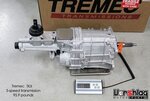
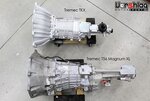
The T56 Magnum was what we would have used, but when the opportunity came up to test the TKX on two chassis in our shop (E46 LS swap endurance car + this 67 Mustang) we jumped at the chance. The TKX seems perfect for this build, as it is lighter (95.9 lbs vs 128 pounds for Magnum XL) and smaller than the Magnums in every dimension.
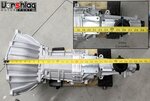
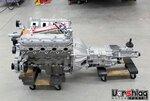
The TKX is a great size for this car, and I took a measurement showing the bellhousing to rear most shifter location above. It is rated for 600 ft-lbs of torque and comes in several gearing options. We had this bolted up to his crate LS7 engine in early May 2020.
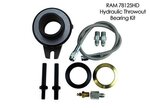
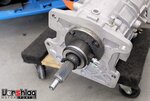
The RAM heavy duty hydraulic throw out bearing slave kit was used, shown above left. This slides over the input shaft and one bolt on the front bearing retainer is replaced with a stud to locate the slave. This was shimmed to work with the LS7 clutch and flywheel that came with the crate engine.
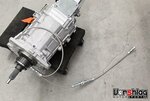
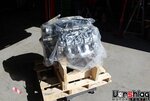
We built custom lines for the Wilwood slave cylinder that Adam already had in the car for use with the T5 the car used to have. The crate motor came pretty complete but Evan removed the intake and exhaust manifolds to make installation easier.
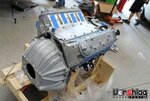
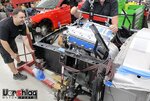
With the appropriate bellhousing attached the engine was attached to our hoist and leveler and Brad and Evan installed this into the chassis in early May 2020. We had a mock-up LS engine in place for months while we worked on the TKX crossmember and other work.
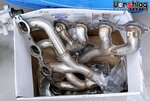
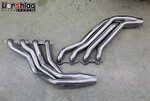
The stock Tri-Y manifolds were too bulky to fit but these 1-7/8" stainless long tube headers we developed for another LS swap happened to fit perfectly. After 12 different chassis we have swapped so far, we FINALLY got lucky and had one set of headers that actually fit. This saved us MONTHS of development work. I will show the header install in another section, below.
ROLL CAGE WORK
In late May we made some good progress on the roll cage. We had already cut out the old 4-point roll bar, relocated the main hoop back almost 10 inches and added some "feet" to mount that onto the rear seat shelf. This gives more room to the driver and we were able to raise up the hoop to nearly touch the roof skin.
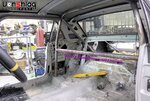
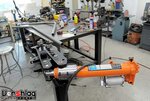
The rear downbars were re-routed to the trunk and then Evan started on the forward hoops along the top of the doors and down the A-pillars.
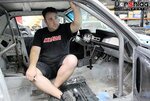
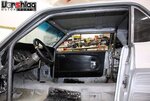
That worked out well, and we will not add a "dash bar" - which would require a lot more surgery. Instead the factory dash will remain intact. This car is being built for fun HPDE and Time Trial events, not wheel to wheel racing. It will also be street driven, so some compromises are being made to accommodate both track and street use.
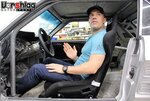
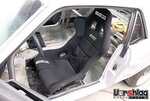
At the end of May, Adam came by and we test fit him in the car (above left) with multiple seats, including this Sparco EVO II and his Corbeau seats the car came in with. This helped us design the floor mounting brackets, which will also reinforce the somewhat weak factory floor.
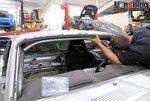
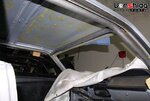
The shop schedule got pretty hectic but at the end of July, in his last weeks with us full time, Evan managed to wrap up the upper windshield bar. This was bent, fitted, and tacked in place.
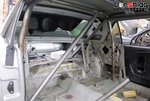
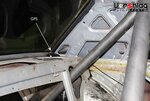
He also finished the main hoop diagonal (above left), which was fitted around Adam's seating position. The rear down bars were also tacked in place with load spreader plates in the trunk. The only tubes left are the harness bar and door bars, which will be "NASCAR" style and cut into the composite doors. The cage is only tacked in place, and the front tubes land on removable plinth boxes. When the door bars are complete we will drop the cage down off the plinths, finish TIG weld the tops of the cage, then raise it back up and finish the rest of the welding in situ.
COOLING & OILING SYSTEM PARTS ADDED
Back in July, as the he LS7 and TKX drivetrain were installed, it was time to start looking at the cooling and oiling system parts needed. Adam had a nice oversized aluminum radiator and large electric fan, so those were reinstalled and will be utilized - with some additional shrouding panels ahead of the radiator.
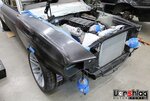
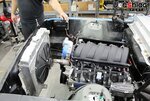
It was time to lay out where the coolant reservoir and oil tank would fit. We ordered this billet remote coolant reservoir from Radium and it can fit lots of places, since the size is pretty compact. But not there, above right. Something else needs to go there.
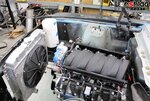
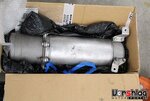
The oil settling tank needed for the LS7 dry sump system is rather large, but the OEM version is one of the only ones out there that has an actual dip stick. It seems crazy, but its true - so we ordered one of these from a local race shop. Measuring proper oil level in aftermarket dry sump tanks is amazingly difficult. I asked Evan make a cardboard cylinder to mimic the OEM tank's shape and it looked like nowhere would be good fit, without some cutting.
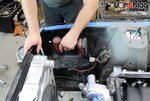
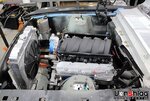
We determined that the only viable spot for this tall oil tank was the RF corner of the engine bay, and Evan cut away some of the inner fender to make room. It was at this point that we realized that we needed the fenders, hood, and headlight buckets installed to lock down the final location - as the tank was going to need every inch of room vertically, and would be close to the headlights and tires.
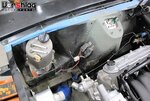
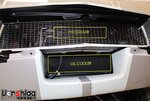
This is where we stopped on these systems in July 2020. We needed to finish the fuel system to finalize layout of the regulator and cold air inlet tube, and we needed the nose back on the car to layout the engine oil and power steering coolers. We knew roughly where they could fit but didn't want to order those pieces until we were sure and had the body all put together.
POWER STEERING PUMP
Adam had issues with the power steering pump with the old 1985-90 5.0L Ford V8, and had purchased an expensive KRC road race style power steering pump kit to fix that issue with on the old V8.
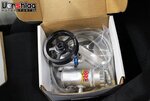
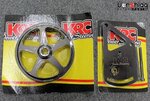
When it was determined that he wanted to stick with hydraulic power steering on the LS7 engine, we called up and ordered the LS7 bracket and proper pulley (above right) for use with the LS brackets and RPM range the engine could see.
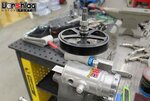
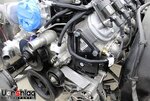
These parts arrived after Evan had left us, but he came back for a few days in September and knocked out the pulley swap, which is not a trivial task unless you have the right puller and installation tools. The bracket bolted to the block, as shown above.
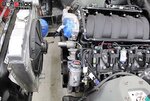
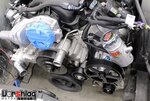
I admit to being a little worried that this pump made for a Ford would fit the GM LS7 engine (because there are 3 GM LS engine pulley fore-aft placements), but with the help of KRC we ordered the right parts and it all bolted up. One less thing to worry about, and with a proper cooler and some hoses to the rack we should be golden.
FUEL SYSTEM PLUMBED & HOLLEY EFI WIRED
Back in early June we had convinced Adam that the stock fuel rail was going to be trouble to work around, due to the planned fuel system plumbing route on the other side of the engine bay.
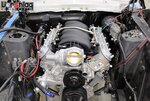
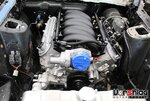
An aftermarket Holley LS7 fuel rail kit was ordered and installed in late June. This will allow us to install a fuel "return style" fuel system in this car more easily and cleanly.
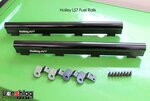
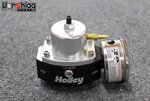
Along with the rail kit, the pressure regulator also came from Holley. We're trying to stick within this brand when we can, for several reasons.
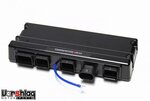
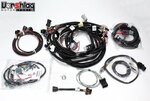
The Holley Terminator X-Max EFI system was chosen, based on experience with our tuner Jon Simpson as well as Evan's own experience. This system has a lot of power and control for the cost, and near infinite tunability. It can also control the drive-by-wire LS7 throttle body and pedal.
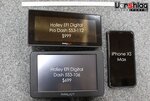
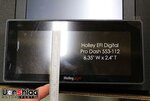
We gave Adam several digital dash choices as well, including these two Holley versions above. He went with their Pro Dash 553-112, which is shown above right. This has touch screen capability so you can literally create buttons on the screen to touch to turn on or off systems. Full color TFT display, should be pretty slick.
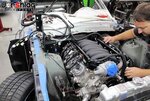
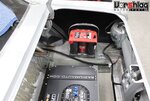
The EFI parts arrived in July and Evan got to work. An Odyssey Red Top AGM battery replaced the old lead-acid battery in the trunk, which was wired into the Holley system for initial testing. We will mount this with one of our brackets for the Odyssey 75-25 series to secure it in all 3 axis.
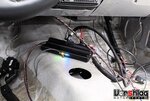
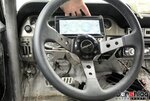
Within a few hours the plug-and-play harness was installed, the ECU was wired in, and the digital dash was connected. It all fired up and communicated perfectly.
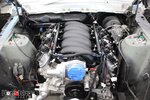
If we had oiling and fuel systems on the car we would have cranked it that day in July! But by the time that the Fragola parts arrived for the plumbing, Evan had left to start his own shop. Luckily he came for handful of days back to wrap up some things on this Mustang in late August/September 2020.
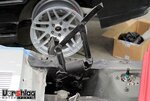
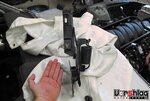
The OEM hinges immediately became an issue. These spring loaded units are big and bulky - they take up some much needed room under the hood, where we needed to place the fuel pressure regulator and coolant reservoir. We found some fancy billet versions that were much smaller, but in the end the customer decided to go with the stock units sans springs.
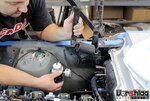
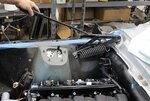
Evan had spec'd all of the components for the fuel system so he got to work mounting and plumbing everything from the fuel cell forward.
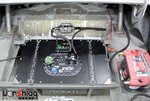
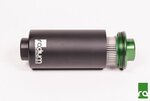
The Radium fuel cell feeds a Radium fuel filter, mounted in one of their heat sink mounts, which is installed in the trunk. An AN -8 line feeds the engine and a -6 AN line goes back to the surge tank return. These pass through a bulkhead in the trunk, and we will build a firewall to separate the trunk from the passenger cabin.
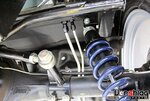
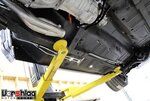
The hard lines were routed above the frame rail and subframe connectors, so they are not the lowest part of the car. The lines were secured with Vibrant dual line clamps throughout.
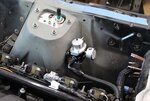
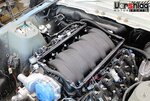
Once they reach the engine bay and pass through another pair of bulkhead connectors they feed to the regulator and fuel rail via Fragola braided lines.
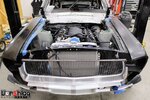
By September 4th the fuel system was fully plumbed and the Holley EFI system wired, other than a few things like fan relays. We just had a few more things to wrap up before taking it to the painter.
RACK AND PINION STEERING & HEADERS
This is where brad jumped into this project to wrap up a few things before the car went to paint. The main item missing was functional steering - we had no steering rack or steering shaft connection. We also needed to final install the long tube headers, which had only been test fit before.
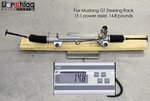
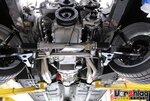
After Jason and I looked at both SN95 and Fox racks, I purchased a brand new Fox Mustang GT power steering rack, which has a known amount of travel and 15:1 assist. This was one the AJE crossmember was made to accept. This was installed and it was time to find the right tie rod ends to connect the Fox rack and S197 front spindle.
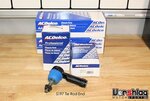
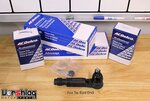
I purchased both Fox Mustang and S197 Mustang tie rod ends - these arrived and we got to work finding the right solution - which might include a hybrid of both.
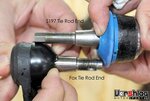
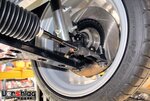
Seeing both parts let us measure the different tie rod threads but similar tapers on the ball joint end, where it needed to connect to the steering arm on the S197 spindles. So the Fox tie rods were utilized.
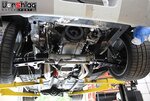
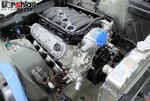
With the rack connected to the spindles it was time for the final install of the long tube headers. We needed these in place to verify the steering shaft clearances.
continued below


The T56 Magnum was what we would have used, but when the opportunity came up to test the TKX on two chassis in our shop (E46 LS swap endurance car + this 67 Mustang) we jumped at the chance. The TKX seems perfect for this build, as it is lighter (95.9 lbs vs 128 pounds for Magnum XL) and smaller than the Magnums in every dimension.


The TKX is a great size for this car, and I took a measurement showing the bellhousing to rear most shifter location above. It is rated for 600 ft-lbs of torque and comes in several gearing options. We had this bolted up to his crate LS7 engine in early May 2020.


The RAM heavy duty hydraulic throw out bearing slave kit was used, shown above left. This slides over the input shaft and one bolt on the front bearing retainer is replaced with a stud to locate the slave. This was shimmed to work with the LS7 clutch and flywheel that came with the crate engine.


We built custom lines for the Wilwood slave cylinder that Adam already had in the car for use with the T5 the car used to have. The crate motor came pretty complete but Evan removed the intake and exhaust manifolds to make installation easier.


With the appropriate bellhousing attached the engine was attached to our hoist and leveler and Brad and Evan installed this into the chassis in early May 2020. We had a mock-up LS engine in place for months while we worked on the TKX crossmember and other work.


The stock Tri-Y manifolds were too bulky to fit but these 1-7/8" stainless long tube headers we developed for another LS swap happened to fit perfectly. After 12 different chassis we have swapped so far, we FINALLY got lucky and had one set of headers that actually fit. This saved us MONTHS of development work. I will show the header install in another section, below.
ROLL CAGE WORK
In late May we made some good progress on the roll cage. We had already cut out the old 4-point roll bar, relocated the main hoop back almost 10 inches and added some "feet" to mount that onto the rear seat shelf. This gives more room to the driver and we were able to raise up the hoop to nearly touch the roof skin.


The rear downbars were re-routed to the trunk and then Evan started on the forward hoops along the top of the doors and down the A-pillars.


That worked out well, and we will not add a "dash bar" - which would require a lot more surgery. Instead the factory dash will remain intact. This car is being built for fun HPDE and Time Trial events, not wheel to wheel racing. It will also be street driven, so some compromises are being made to accommodate both track and street use.


At the end of May, Adam came by and we test fit him in the car (above left) with multiple seats, including this Sparco EVO II and his Corbeau seats the car came in with. This helped us design the floor mounting brackets, which will also reinforce the somewhat weak factory floor.


The shop schedule got pretty hectic but at the end of July, in his last weeks with us full time, Evan managed to wrap up the upper windshield bar. This was bent, fitted, and tacked in place.


He also finished the main hoop diagonal (above left), which was fitted around Adam's seating position. The rear down bars were also tacked in place with load spreader plates in the trunk. The only tubes left are the harness bar and door bars, which will be "NASCAR" style and cut into the composite doors. The cage is only tacked in place, and the front tubes land on removable plinth boxes. When the door bars are complete we will drop the cage down off the plinths, finish TIG weld the tops of the cage, then raise it back up and finish the rest of the welding in situ.
COOLING & OILING SYSTEM PARTS ADDED
Back in July, as the he LS7 and TKX drivetrain were installed, it was time to start looking at the cooling and oiling system parts needed. Adam had a nice oversized aluminum radiator and large electric fan, so those were reinstalled and will be utilized - with some additional shrouding panels ahead of the radiator.


It was time to lay out where the coolant reservoir and oil tank would fit. We ordered this billet remote coolant reservoir from Radium and it can fit lots of places, since the size is pretty compact. But not there, above right. Something else needs to go there.


The oil settling tank needed for the LS7 dry sump system is rather large, but the OEM version is one of the only ones out there that has an actual dip stick. It seems crazy, but its true - so we ordered one of these from a local race shop. Measuring proper oil level in aftermarket dry sump tanks is amazingly difficult. I asked Evan make a cardboard cylinder to mimic the OEM tank's shape and it looked like nowhere would be good fit, without some cutting.


We determined that the only viable spot for this tall oil tank was the RF corner of the engine bay, and Evan cut away some of the inner fender to make room. It was at this point that we realized that we needed the fenders, hood, and headlight buckets installed to lock down the final location - as the tank was going to need every inch of room vertically, and would be close to the headlights and tires.


This is where we stopped on these systems in July 2020. We needed to finish the fuel system to finalize layout of the regulator and cold air inlet tube, and we needed the nose back on the car to layout the engine oil and power steering coolers. We knew roughly where they could fit but didn't want to order those pieces until we were sure and had the body all put together.
POWER STEERING PUMP
Adam had issues with the power steering pump with the old 1985-90 5.0L Ford V8, and had purchased an expensive KRC road race style power steering pump kit to fix that issue with on the old V8.


When it was determined that he wanted to stick with hydraulic power steering on the LS7 engine, we called up and ordered the LS7 bracket and proper pulley (above right) for use with the LS brackets and RPM range the engine could see.


These parts arrived after Evan had left us, but he came back for a few days in September and knocked out the pulley swap, which is not a trivial task unless you have the right puller and installation tools. The bracket bolted to the block, as shown above.


I admit to being a little worried that this pump made for a Ford would fit the GM LS7 engine (because there are 3 GM LS engine pulley fore-aft placements), but with the help of KRC we ordered the right parts and it all bolted up. One less thing to worry about, and with a proper cooler and some hoses to the rack we should be golden.
FUEL SYSTEM PLUMBED & HOLLEY EFI WIRED
Back in early June we had convinced Adam that the stock fuel rail was going to be trouble to work around, due to the planned fuel system plumbing route on the other side of the engine bay.


An aftermarket Holley LS7 fuel rail kit was ordered and installed in late June. This will allow us to install a fuel "return style" fuel system in this car more easily and cleanly.


Along with the rail kit, the pressure regulator also came from Holley. We're trying to stick within this brand when we can, for several reasons.


The Holley Terminator X-Max EFI system was chosen, based on experience with our tuner Jon Simpson as well as Evan's own experience. This system has a lot of power and control for the cost, and near infinite tunability. It can also control the drive-by-wire LS7 throttle body and pedal.


We gave Adam several digital dash choices as well, including these two Holley versions above. He went with their Pro Dash 553-112, which is shown above right. This has touch screen capability so you can literally create buttons on the screen to touch to turn on or off systems. Full color TFT display, should be pretty slick.


The EFI parts arrived in July and Evan got to work. An Odyssey Red Top AGM battery replaced the old lead-acid battery in the trunk, which was wired into the Holley system for initial testing. We will mount this with one of our brackets for the Odyssey 75-25 series to secure it in all 3 axis.


Within a few hours the plug-and-play harness was installed, the ECU was wired in, and the digital dash was connected. It all fired up and communicated perfectly.

If we had oiling and fuel systems on the car we would have cranked it that day in July! But by the time that the Fragola parts arrived for the plumbing, Evan had left to start his own shop. Luckily he came for handful of days back to wrap up some things on this Mustang in late August/September 2020.


The OEM hinges immediately became an issue. These spring loaded units are big and bulky - they take up some much needed room under the hood, where we needed to place the fuel pressure regulator and coolant reservoir. We found some fancy billet versions that were much smaller, but in the end the customer decided to go with the stock units sans springs.


Evan had spec'd all of the components for the fuel system so he got to work mounting and plumbing everything from the fuel cell forward.


The Radium fuel cell feeds a Radium fuel filter, mounted in one of their heat sink mounts, which is installed in the trunk. An AN -8 line feeds the engine and a -6 AN line goes back to the surge tank return. These pass through a bulkhead in the trunk, and we will build a firewall to separate the trunk from the passenger cabin.


The hard lines were routed above the frame rail and subframe connectors, so they are not the lowest part of the car. The lines were secured with Vibrant dual line clamps throughout.


Once they reach the engine bay and pass through another pair of bulkhead connectors they feed to the regulator and fuel rail via Fragola braided lines.

By September 4th the fuel system was fully plumbed and the Holley EFI system wired, other than a few things like fan relays. We just had a few more things to wrap up before taking it to the painter.
RACK AND PINION STEERING & HEADERS
This is where brad jumped into this project to wrap up a few things before the car went to paint. The main item missing was functional steering - we had no steering rack or steering shaft connection. We also needed to final install the long tube headers, which had only been test fit before.


After Jason and I looked at both SN95 and Fox racks, I purchased a brand new Fox Mustang GT power steering rack, which has a known amount of travel and 15:1 assist. This was one the AJE crossmember was made to accept. This was installed and it was time to find the right tie rod ends to connect the Fox rack and S197 front spindle.


I purchased both Fox Mustang and S197 Mustang tie rod ends - these arrived and we got to work finding the right solution - which might include a hybrid of both.


Seeing both parts let us measure the different tie rod threads but similar tapers on the ball joint end, where it needed to connect to the steering arm on the S197 spindles. So the Fox tie rods were utilized.


With the rack connected to the spindles it was time for the final install of the long tube headers. We needed these in place to verify the steering shaft clearances.
continued below
- Thread starter
- #36
continued from above
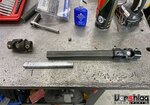
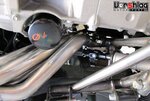
We took some existing parts that Adam had on the car, added a new steering U-joint at the rack, and built a custom 2-piece steering shaft. This connected his steering column to the Fox rack, and clearance to our headers was ample. Hot damn! We had a car that steered on September 15th, 2020. We were almost ready to load up for the body shop...
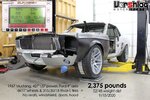
Of course we had to get a "weight in progress" on this chassis. I was a bit startled at the weight we took, 2375 pounds. This weight is with most of the cage, the 18x11" wheels, 14" Brembo front brakes, Ford 9", complete LS7 engine, and most of the bodywork. The doors weigh an additional 29 pounds for the pair. There is no windshield, seats, and probably 50 pounds of cage are still in the future. There's no hood, either. But still, our goal of sub 2700 pounds is not impossible at this stage.
LOADING UP AND HEADING TO PAINT
It was a beautiful day in late September when Brad and I loaded this car into the trailer. It let us take a few pictures of this car outside, sitting at a proper ride height, with these giant wheels and tires.
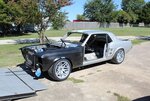
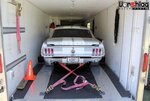
I was hoping the rear fenders wouldn't need a lot of massaging at the body shop, Heritage Collision in Sherman, TX. The owner Shiloh has dome plenty of flare jobs for us in the past and knows what needs to be tested, how much clearance we need.
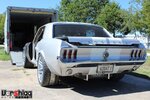
Normally we would do this fab work ourselves, but at this moment I had no fabricator, as we were "between hires" - but I trust Shiloh and he is one of the only people we would let do this level of fab work and have it be right.
HINGE MODS
In early October, while we were waiting for our slot to open up at the body shop, Adam had made his decision on the hinges. Instead of aftermarket versions he wanted to keep the OEMs, so our new fab guy (who came and went in October) got to work.
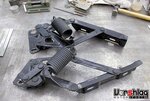
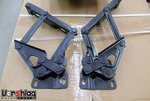
He removed the springs and trimmed down the flanges to make room for the regulator that had been mounted. We would leave it up to the body shop to align and fit these to the hood.
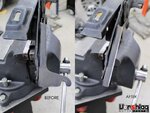
PANEL FITTING AND BODY WORK
On October 13th I dropped off the Mustang at Heritage Collision and they got right to work. We brought the doors and Maier Racing hood, which we had never even removed from the box. The Maier lower air dam was ordered by Adam and shipped direct to the body shop.
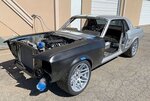
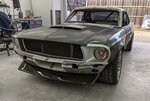
Like I said in the section about the poorly fitting fenders above, they spent a fair amount of time making the fenders and hood fit with the factory shaped composite doors (which themselves fit great). Then they installed the front Shelby style grill surround and new lower air dam. Shiloh and his crew also fitted the front wheel arches side to side for proper steering clearance.
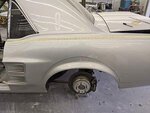
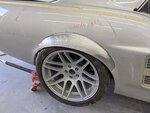
The other wizardry they managed was reworking the stock rear sheet metal to clear the 315mm tires at full bump travel - as shown above right. They know to remove the springs and compress the suspension so the tire can be checked at full bump. These flares look amazing and match the front bodywork perfectly.
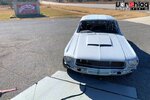
Lots of hours spent getting the car blocked, sanded, fitted, and primed. We still have some work to do so they will come back after the first track test and paint the interior, trunk, and underhood before tackling the outside. The bodywork was done to a high standard, which makes sense if the car is to spend any time in the Optima / Holley LS Fest / Ford Fest / Goodguys circuit of competition events.
WHAT'S NEXT?
Since picking the car up on December 24th we have been extremely busy on other customers' cars in the shop, as well as wrapping up some shop construction. Look for another update from us after the remaining oil system work is completed. A number of items have been ordered for that, then we can tackle the rest of the cage work, then clearance the doors like our endurance E46 below (which also has a TKX). Myles and Zach can knock out the cage work, no problems.
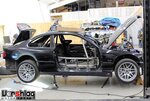
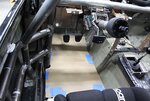
The false floor pattern recently started (above right) on the E46 needs to be replicated in aluminum on the '67 Mustang as well, with a dead pedal incorporated. We also have to CNC machine the final production version of this 1st gen Mustang camber plate, shown below left in Solidworks. Why? Because if this car tests well on track, we plan to do this conversion again on another 1st gen Mustang - and soon.
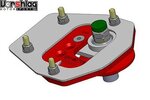
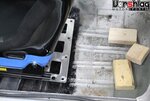
We also liked how much headroom we gained in this car by removing the flimsy 3 inch tall "shelf" that the stock seats sit on, so we will make our seat bracket base a production part for the same type of install as well. The oiling system, coolers, and coolant reservoir need to be wrapped up, and something done about the bumpers. Then we should be ready for a dyno tune and track test. Tune in next time to see these tasks wrapped up, and I will definitely post up before the track test.
Thanks for reading,


We took some existing parts that Adam had on the car, added a new steering U-joint at the rack, and built a custom 2-piece steering shaft. This connected his steering column to the Fox rack, and clearance to our headers was ample. Hot damn! We had a car that steered on September 15th, 2020. We were almost ready to load up for the body shop...

Of course we had to get a "weight in progress" on this chassis. I was a bit startled at the weight we took, 2375 pounds. This weight is with most of the cage, the 18x11" wheels, 14" Brembo front brakes, Ford 9", complete LS7 engine, and most of the bodywork. The doors weigh an additional 29 pounds for the pair. There is no windshield, seats, and probably 50 pounds of cage are still in the future. There's no hood, either. But still, our goal of sub 2700 pounds is not impossible at this stage.
LOADING UP AND HEADING TO PAINT
It was a beautiful day in late September when Brad and I loaded this car into the trailer. It let us take a few pictures of this car outside, sitting at a proper ride height, with these giant wheels and tires.


I was hoping the rear fenders wouldn't need a lot of massaging at the body shop, Heritage Collision in Sherman, TX. The owner Shiloh has dome plenty of flare jobs for us in the past and knows what needs to be tested, how much clearance we need.

Normally we would do this fab work ourselves, but at this moment I had no fabricator, as we were "between hires" - but I trust Shiloh and he is one of the only people we would let do this level of fab work and have it be right.
HINGE MODS
In early October, while we were waiting for our slot to open up at the body shop, Adam had made his decision on the hinges. Instead of aftermarket versions he wanted to keep the OEMs, so our new fab guy (who came and went in October) got to work.


He removed the springs and trimmed down the flanges to make room for the regulator that had been mounted. We would leave it up to the body shop to align and fit these to the hood.

PANEL FITTING AND BODY WORK
On October 13th I dropped off the Mustang at Heritage Collision and they got right to work. We brought the doors and Maier Racing hood, which we had never even removed from the box. The Maier lower air dam was ordered by Adam and shipped direct to the body shop.


Like I said in the section about the poorly fitting fenders above, they spent a fair amount of time making the fenders and hood fit with the factory shaped composite doors (which themselves fit great). Then they installed the front Shelby style grill surround and new lower air dam. Shiloh and his crew also fitted the front wheel arches side to side for proper steering clearance.


The other wizardry they managed was reworking the stock rear sheet metal to clear the 315mm tires at full bump travel - as shown above right. They know to remove the springs and compress the suspension so the tire can be checked at full bump. These flares look amazing and match the front bodywork perfectly.

Lots of hours spent getting the car blocked, sanded, fitted, and primed. We still have some work to do so they will come back after the first track test and paint the interior, trunk, and underhood before tackling the outside. The bodywork was done to a high standard, which makes sense if the car is to spend any time in the Optima / Holley LS Fest / Ford Fest / Goodguys circuit of competition events.
WHAT'S NEXT?
Since picking the car up on December 24th we have been extremely busy on other customers' cars in the shop, as well as wrapping up some shop construction. Look for another update from us after the remaining oil system work is completed. A number of items have been ordered for that, then we can tackle the rest of the cage work, then clearance the doors like our endurance E46 below (which also has a TKX). Myles and Zach can knock out the cage work, no problems.


The false floor pattern recently started (above right) on the E46 needs to be replicated in aluminum on the '67 Mustang as well, with a dead pedal incorporated. We also have to CNC machine the final production version of this 1st gen Mustang camber plate, shown below left in Solidworks. Why? Because if this car tests well on track, we plan to do this conversion again on another 1st gen Mustang - and soon.


We also liked how much headroom we gained in this car by removing the flimsy 3 inch tall "shelf" that the stock seats sit on, so we will make our seat bracket base a production part for the same type of install as well. The oiling system, coolers, and coolant reservoir need to be wrapped up, and something done about the bumpers. Then we should be ready for a dyno tune and track test. Tune in next time to see these tasks wrapped up, and I will definitely post up before the track test.
Thanks for reading,
